 UK Royal Navy (1909-1922)
UK Royal Navy (1909-1922)1909 program, I-class 1913: Builder class: HMS Acheron, Archer, Ariel, Attack, Badger, Beaver * Admiralty I class: Defender, Druid, Ferret, Forester, Goshawk, Hind, Hornet, Hydra, Jackal, Lapwing, Lizard, Phoenix, Sandfly, Tigress. * Yarrow Specials: HMS Firedrake, Lurcher, Oak. * Aussie Rivers: HMAS Parramatta, Yarra, Warrego, Huon, Swan, Torrens
WW1 British Destroyers:
26 knotters | 27 knotters | 30 knotters | 33 knotters | Turbine destroyers | River class | Cricket class | Tribal class | Beagle class | Acorn class | Acheron class | Acasta class | L class | M class | Repeat M class | Medea class | Faulknor class FL | Marksman class FL | Parker class FL | Talisman class | Shakespeare class FL | R class | S class | Repeat R class | V class FL | Scott class FL | V class | W classThe Acheron class (I class from 1913) were the subject of the 1910-11 Programme and followed the path of the Acorn, reverting to oil instead of coal on the Beagle class and also based on a standard Admiralty design to standardize the class but also five others were builders’ specials. They also differed by havung two instead of three short funnels and for the rest kept about the same dimensions, tonnage, powerplant and armament now counting on Mark 7 4-in guns and 12 pounders, but still single torpedo tubes. They were completed for some in late 1912 and their crews had time to train before the war broke out. In that matter, four were lost, HMS Attack was torpedoed in December 1917 off Egypt, HMS Phoenix torpedoed by U-27 in the Adriatic in 1918, Ariel hit a mine on 2 August 1918. They saw plenty of action mostly as convoy escorts for the duration of the war, made some kills and misses, two ended as minelayers and the rest were sold in 1922, after just ten years of service.
More were built than the Acorns (twenty built by eight shipyards), some 23, but this was far more diverse. First off, they were only 14 Admiralty designs, completed by 6 Builder’s designs (from Thornycroft and William Denny) which wanted to propose a detailed alternative, three three Yarrow’s specials, which were a kind of superfast variant proposal, also built on stock, and lastly six “Australian River class” that were a bit confusing as they were named after Australian rivers, some in Australia (Cockatoo) and had nothing to the 1903 River class. The latter had a longer career, discarded in 1929-31.
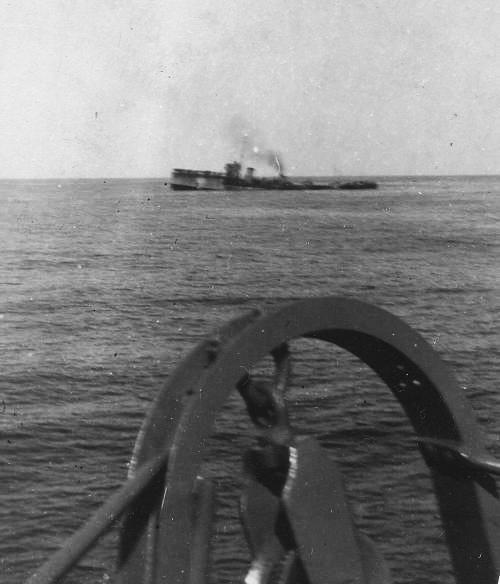
The sinking of HMS Attack in 1917, she had 500 men from the steamer Aragon aboard when she was torpedoed. Her hull broke in two and yet she sank in seven minutes.
Development
A repeat of the Acorns, with oil and better armament
To understant the lineage we must go back to te River class, a return from the trials to achieve 33 knots without (VTE), and then with turbines before trialling oil fired VTE/turbines, all forecastle destroyers, the River class, then revert to VTE and more range for the Tribal class, before the coal-burning Beagle class of the 1908–1909 shipbuilding programme designed from initial fears of the lack of oil.
The Admiralty soon reverted to oil between drawbacks and a rapidly changing international situation. The next Acorn had a smaller storage space and better optimized bunkerage and were made smaller and cheaper vessels, saving space was for structural improvements additions later, but these were also the first admiralty designs. For the first time a standardized hull design worked with state engineers and private consultants from the DNT (Directorate of Naval Construction) proposals, approved in July 1909 for the Acorns. It was believed this alos freed some detail design work, gain time, save money and attract more shipyards, bidding for more orders with extra competition.
These advantages were retook when a serie of destroyers were needed as for the 1910-11 naval programme. They were essentially a repeat-Acorn design, with 20 ordered again. However the situation got complicated as private yards, namely Thornycroft, Denny and Yarrow proposed designs for their own. They were accepted, six “builder I class” for the first two, and three “Special I class” from Yarrow which wanted to improve on speed. This is why they differed in specs, that needs to be detailed separately although also sharing many common traits. And three more were ordered for the RAN, based on admiralty designs but with some percs as they were tailored to proper Austrlian needs, including the possibility to be built later in Australia. Three were, which brought up for a total of six for the RAN (Royal Australian navy), and 23 total. The latter had at least a more consequent service of 20 years. They formed generations of destroyer crews that would be needed in WW2.
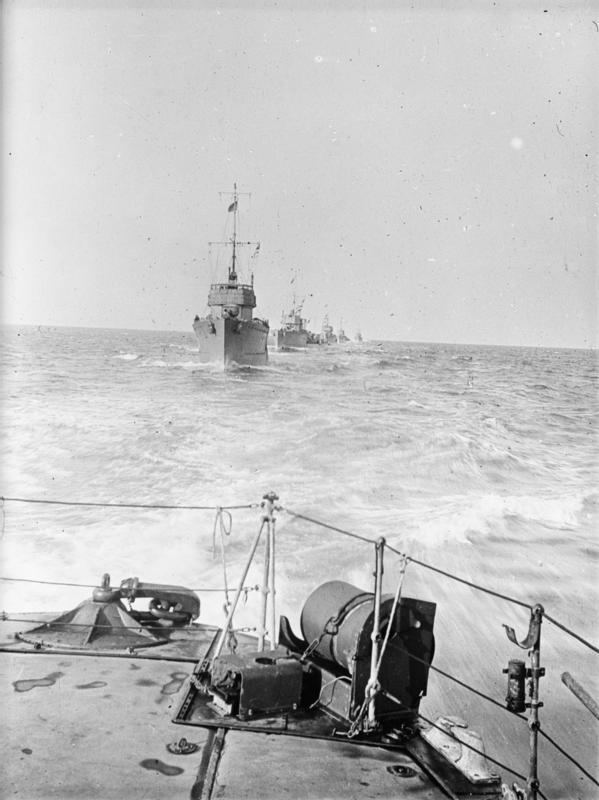
Acheron class destroyers as part of the Harwhich Force. Most fought at three major battles including Jutland but ended from 1916-17 in the Mediterranean, replaced by more modern destroyers.
The Admiralty I Design
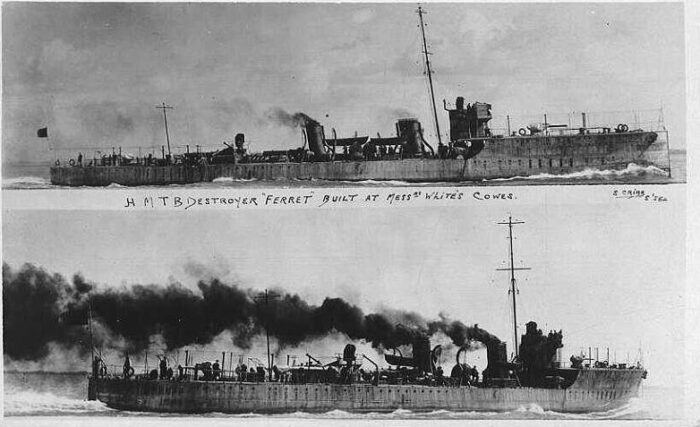
HMS Ferret, an admiralty White shipyards design.
Let’s start with the Admiralty I class: They differed from the Acorns in having only two funnels, both short, with the foremost being thicker than the aft one, after truncating exhausts in it. The 12-pounder guns were also mounted slightly further forward compared to the Acorns. But apart that they were very similar in design and construction.
The Admiralty built ships were of course more homogenerous, but among these fourteen ships, John Brown and Company at Clydebank delivered the Hind, Hornet and Hydra with how own patented Brown-Curtis type turbines and on two shafts. The rest of the class had three shafts, and typically Parsons steam turbines and Yarrow boilers.
⚙ Admiralty specifications |
|
| Displacement | c750 tons standard, 990t FL |
| Dimensions | 246 ft 6 in x 25 ft 6 in x 7 ft (75 x 7.8 x 2.7 m) |
| Propulsion | 3 shafts steam turbines, 3 oil-fired boilers 13,500 shp (10,067 kW)* |
| Speed | 27-30 knots (50 km/h) |
| Range | 170 tons oil, c800 nm? |
| Armament | 2× BL 4-in/40 Mark VIII, 2× QF 12-pdr 12 cwt Mark I, 2× 21-in TTs |
| Crew | 72 |
The Builder I Design
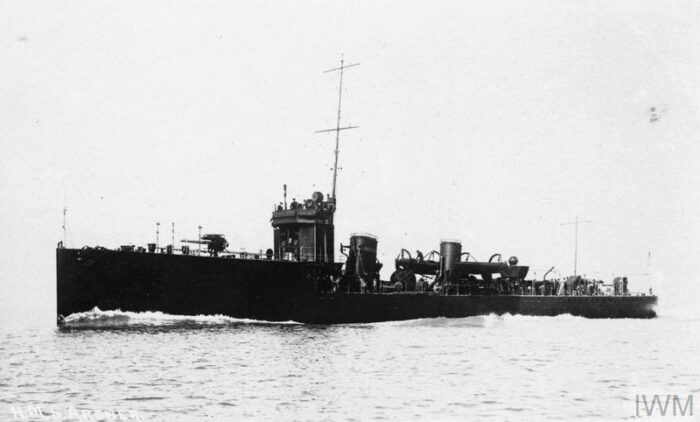
HMS Ferret on sea trials, 1912
This sub-class proposed by Thornycroft and Yarrow, Denny, comprised Acheron, Archer, Ariel, Attack, Badger, Beaver. HMS Archer and Attack used steam at higher pressures and Badger and Beaver were completed with geared steam turbines for evaluation purposes, achieving speeds of 30.7 kn (56.9 km/h; 35.3 mph) in trials.
⚙ Builders specifications |
|
| Displacement | 730 to 780 tons standard, c850t FL |
| Dimensions | 246 ft 6 in x 25 ft 6 in x 7 ft (75.13 x 7.77 x 3 m) |
| Propulsion | 3 shafts steam turbines, 3 oil-fired boilers 13,500 shp (10,067 kW) |
| Speed | 27 knots (50 km/h) |
| Range | 170 tons oil, c800 nm? |
| Armament | 2× BL 4-in/40 Mark VIII, 2× QF 12-pdr 12 cwt Mark I, 2× 21-in TTs |
| Crew | 72 |
Yarrow Specials (or “Special I class”)
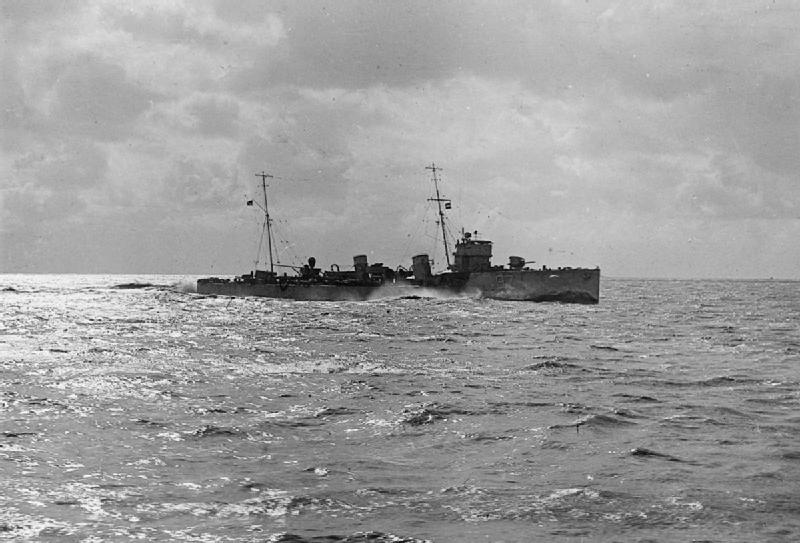
HMS Firedrake at full speed, date unknown. At 35 knots with adequate range they blasted all records for British destroyers at the time.
The sub-class was composed of HMS Firedrake (launched 9 April 1912), HMS Lurcher (launched 1 June 1912) and HMS Oak (launched 5 September 1912).
Sir Alfred Yarrow maintained to the admiralty that he could be build strong and seaworthy destroyers capable of maintaining 32 knots (59 km/h; 37 mph). Based on his assertions, the admiralty contracted his Scotshound, Glasgow company for three boats placed with the firm. To achieve his goal, engieneers made it a bit larger than the rest of the Acheron class and more powerful. With larger boilers and a different arrangement he managed to obtain 20,000 shp (15,000 kW). They were similar also the John Brown-built’s Hind, Hydra and Hornet with their two shafts, but with 2 Yarrow-type water-tube boilers feeding two Parsons turbines. HMS Firedrake, Lurcher and Oak were also different from the rest in many aspects and much faster, exceeded their contract speed. HMS Lurcher making over 35 knots (65 km/h; 40 mph) on trials, showing their capabilities.
⚙ Yarrow’s specials specs. |
|
| Displacement | 790 tons standard, c900t FL |
| Dimensions | 246 ft 6 in x 25 ft 6 in x 7 ft (75.13 x 7.77 x 3 m) |
| Propulsion | 2 shafts Parsons steam turbines, 3 oil-fired Yarrow boilers 20,000 shp |
| Speed | 35 knots (65 km/h) |
| Range | 170 tons oil, c800 nm? |
| Armament | 2× BL 4-in/40 Mark VIII, 2× QF 12-pdr 12 cwt Mark I, 2× 21-in TTs |
| Crew | 72 |
Construction
So not all were “admiralty design” and yetmost yard that took part in the previous class also built the Acheron class destroyers on almost similar plans. They were:
John Brown and Company: Hind, Hornet, Hydra, admiralty’s
William Denny & Brothers: Defender, Druid (Admiralty), Attack, Beaver, Bagder (Builder), HMAS Yarra (Aussie River)
Fairfield Shipbuilding & Engineering Company, Govan: HMAS Paramatta (aussie River)
R. W. Hawthorn Leslie & Company: Jackal, Tigress (Admiralty)
Swan Hunter & Wigham Richardson: Sandfly (Admiralty)
Yarrow & Company, Scotstoun, Glasgow Archer, Attack (Builder)
John I. Thornycroft & Company: Acheron, Ariel (Builder)
J. Samuel White & Company: Ferrt, Forester (Admiralty)
William Beardmore & Company, Dalmuir: Goshawk (Admiralty)
Vickers, Barrow-in-Furness: Phoenix (admiralty)
A. & J. Inglis was not selected this time.
In addition there was also the Australian built:
Cockatoo Dockyard: Yarra (assembled from parts from Fairfield), Huon, Swan, Torrens. They were built more slowly and actually the latter were completed in August and December 1915, the rest in April and December 1914.
The Acheron class (‘I’ class in 1913) of the 1910-11 program were a repeat and unlike the preceding Acorn class, the lead vessel, HMS Acheron was one of the builders proposals, a privately designed improvement over the Acorns by John I. Thornycroft & Company, Woolston. She was the first laid down, yet not the first launched, in June 1911 versus HMS Ferret (12 April) by White.
having two funnels, short, but the foremost being thicker and the 12-pounder guns mounted slightly further forward. Based on the need for the admiralty to have a heavier armament, led to a 25% increase in displacement, producing the new Acasta class, very close to the 1000-tons mark for the first time. The British destroyer tree would even brounch out more in the following years with two more types, destroyer leaders and light destroyers obeying different roles better.
Design of the class
Hull and general design
The Acheron were very comparable to the previous Acorn class, both smaller than the previous Beagle class.
-Average displacement was 750-790 long tons normal and 860-900 long tons full load.
-The standard was 246ft (75 m) however versus 246 feet (74.98 m) overall on the Acorns. So practically identical.
-The beam was was however greater at 26 feet (7.9) and up to 26fr 9in (8.15m) depending of the yard, versus 25 feet 3 inches (7.70 m) on the Acorns.
-Draught varied between 8 ft 6 in (2.59 m) to 9 ft (2.7 m) versus 7 feet 4+1⁄2 inches (2.248 m) so they had more buoyancy, which added to the extra beam, made them more stable.
Their seaworthiness was however not muvh improved with their similar deck height and forecastle with little flare. Hull shapes overall were about the same, they had the same near-straight bow and rounded poop plus a single rounded aft rudder, same shafts struts attachements and propellers. Most had three (admiralkty design), the remainder two propeller shafts, notably the superfast Yarrow “specials”.
The crews were of 70, more or less, with many variations, comparable to the Acorn’s 72 officers and ratings. In general, five officers were present. They had two whalers under davits abaft the third funnel, a small cutter on the starboard side, close to the amdiship funnel. The forcastle was still about 1/4 of the hull’s lenght, the bridge was moved back unlike the Beagles, and like the Acorsn situated mid-way between the forecastle’s end and lower deck. There was a similar tall mainmast, small pole aft mast aft, small quarterdeck structure on the main deck and the two low funnels that caracetrized immediately the Acheron class compared to their predecessors. They were also echeloned air intakes of various sizes all along with deck access hatches.
The funnels were unequal. The fore funnel was much thicker as it combined the truncated exhausts pipes of the two forwards boilers and the aft one, the single aft boiler. Both had moderate caps but they were equally low and raked. They had also two projectors on platforms, one sitting forward on top of the bridge, another between the torpedo tubes. There was a also spotting top on the composed mainmast.
Like the Beagles, and unlike the Acorn class, the forecastle gun was raised on a platform, close to a bandstand but lower. It was shaped in such a way to not generate additional spray.
The main bridge was fully open with canvas and no roof but this was changed during the war with rigid paneling, windows and a semblance of roof thankls to a top frame with optional canvas, quite surfeul when opeating in the Mediterranean. For some operations they could have additional sandbags even. The cabin below housed the map table. The aft steering wheel was located behind the aft mast with voice pipes. Chadburn, voice pipes, repeater, and indicators plus flag stowage bin were part of the open bridge.
Powerplant
The standard design featured thhree shafts, each driven by its own Parsons steam turbines, and fed by its own Yarrow boiler. This was a simple arra,gement and the Admiralty trusted Parsons and Yarrow as the best for their trade. This was efficient, trusted, reliable, running on oil with a base bunkerage of around 178 tons, but it could change between yards. Average top speed was 27 knots. It was certainly below in 1918 after intensive operations. This was rated for 13,500 shp (10,067 kW) on average but HMS Acheron and Ariel (builder’s Thornycroft specials) developed 15,500 shp (11,558 kW).
HMS Badger and Beaver from Denny diverged from the rest by having three sets Parsons semi-geared steam turbines (the “Parsons’s specials”), and three Yarrow boilers.
HMS Ferret, Forester from White shipyard had the same 3 Parsons steam turbines as the others but coupled with White-Forster boilers intead of Yarrow.
HMS Hind, Hornet, Hydra from John Brown, also Admiralty designs, had two shafts with Brown-Curtis turbines and two Yarrow-type oil-fired boilers
HMS Oak, Lurcher, Firedrake, the three famed “Yarrow Specials” had also two shafts with Parsons turbines but three Yarrow oil-fired boilers. The supplementary boiler needed extra nelght, but procured a boost to 20,000 shp (14,914 kW) for 32 knots as contracted, more on trials.
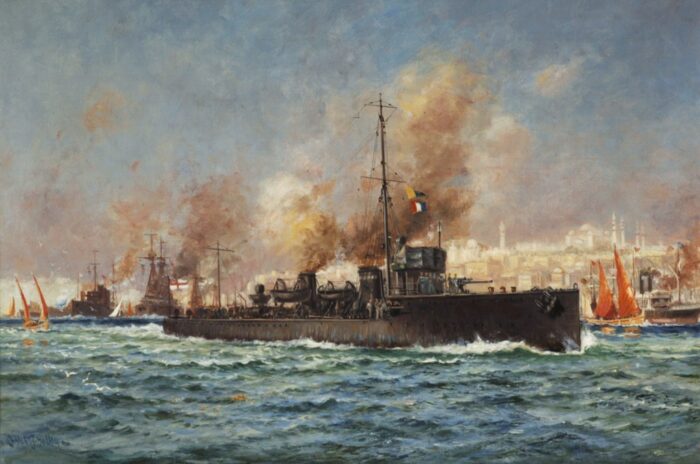
Painting by Charles John De Lacey of HMS Forester off Constantinople.
Armament
For the previous design, the admiralty wanted an heavier armament compared to the Beagles despite a smaller size. Two 4-inch (102 mm) L/40 BL Mk VIII guns were to be installed on the forecastle, and at the poop, plus two 12-pounder (76 mm) QF 12 cwt guns on the waist between the first two funnels, echeloned to fire cross deck if needed. The exact samde scheme was repeated for the Acheron class without change. No change either for the two 21-inch (533 mm) torpedo tubes in axis with two reload torpedoes. Like for the Acorns, these were longer tubes accepting more modern torpedoes. They were were located aft of the funnels with the searchlight post between them.
Wartime additions were limited to a 3-pounder (47 mm) Vickers anti-aircraft gun (AA) and depth charge racks as well as Y-guns.
4-in Mark VIII/40 (101.6 mm)
These were designed in 1908 and entered service on the HMS Swift, Tribals, Beagle, Acorns and Acherons.
⚙ specifications 4-in Mark VIII |
|
| Weight | 2,912 pounds (1,320 kg) |
| Barrel lenght | 159.2 inches (4.044 m) bore 40 calibres |
| Elevation/Traverse | -10° to +20°, 360 |
| Loading system | Welin single-motion screw breech |
| Muzzle velocity | 2,287 feet per second (697 m/s) |
| Range | 10,210 yards (9,340 m) |
| Crew | 8 |
| Round | 31 pds (14.06 kg) Common lyddite |
| Rate of Fire | 6-8 RPM |
QF 12-Pdr 12 cwt
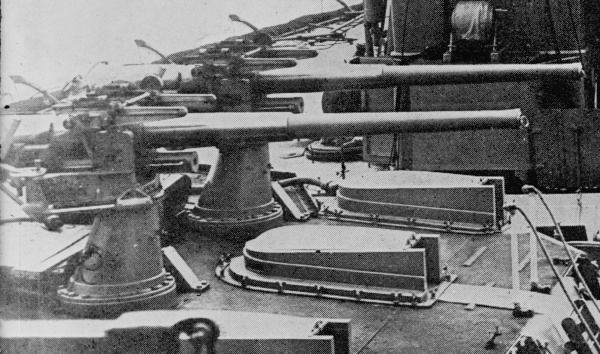
The QF 12 pounder 18 cwt gun (Quick-Firing) was a 3-inch high-velocity naval gun intended at first for battleships to deal with torpedo boats. 18 cwt referred 112 lbx2,016 lb or 914 kg unlike the strick “12 pounder” with was actually 12.5 lb or 5.7 kg. They ended on a lot of capital ships.
They had P. V mountings with 100 rounds per gun just as the “Tribal” group., capable of +20° and -10° which was important to deal with submarines close.
Sights were cam-worked with range dials for 2150 fps also used as .303-in aiming rifles elevating the same, with graduations ending at 19.25° or 8100 yards full charge. Deflection gearing was constant at 43.76, 1 knot= 3.76 arc minutes, for a muzzle velocity of 2197 fps at 2000 yards.
The drift was corrected by inclining the sight 2 degrees with left sights 10.25 inches above the bore, 10 inches left. But the sight could be also used as free sight, with an open sights for the layer. There was no temperature corrector however.
In late 1913, these gun mountings started to receive percussion firing gears.
⚙ specifications 12-pdr, 12 Cwt |
|
| Weight | 2,016 lb (914 kg) |
| Barrel lenght | 150-inch (3.81 m) 50 calibres |
| Elevation/Traverse | |
| Loading system | |
| Muzzle velocity | 2,600 ft/s (790 m/s) |
| Range | 9,300 yards @ +20° (8,500 m @ +20°) |
| Crew | 5 |
| Round | Separate QF 12.5 lb (5.66 kg) |
| Rate of Fire | 20 rd/min |
21-in Torpedoes
The new RGF Mk II 21-in torpedo with the Hardcastle heater was adopted in this class. It ran at 5Okts (93 km/h; 58 mph) over 1000yds (910 m) or 12,000yds (11,000 m) at 30kts (56 km/h; 35 mph). Two spare torpedoes were carried. Instead of the “Short” Mark I they carried the “Long” Mark I at 23 ft 1.25 in (7.042 m) thanks to their longer tubes and then the Mark II. The Mark I long explosive charge was 200 lb (91 kg) of gun cotton, increased later to 225 lb (102 kg). The spare torpedoes were stowed either side at the foot of the searchlight platform on deck.
But the bead and breakfast of these ships in WWI was their Mark II introduced in 1914:
⚙ specs Mark II TORPEDO |
|
| Weight | 1,6t |
| Dimensions | Diameter 534 mm, Length 681 cm |
| Propulsion | Wet Heater |
| Range/speed setting | 5,500 yards (5,000 m)/30 knots |
| Warhead | 280 lbs. (127 kg) wet gun-cotton |

HMS Jackal in Malta, perhaps 1918. Note the colors, light grey structures and black hull. The Pennant Number should read 55, and may have been altered by the Censor for security reasons.
Depth Charges
In July 1912, HMS Alarm was the first fitted for trials of an explosive sweep mated with electrically-fired charge. In May 1918, Nymphe combined a sweep gear with two depth charge throwers (Y-guns) and four stern chutes, 12 charges. In August, 1918, HMS Brisk was equipped with the standard, two depth charge throwers (DCT or Y guns) eight spares, one ‘runner” with 23 charges. They no longer carried Paravanes to compensate for this 7.5 tons increase and some even had to land their aft 4-in gun.
Fire Control
By 1915 fixed voice pipes were added between decks ending with flexible mouths, one for gunnery, one for torpedoes and linking the bridge with the guns, torpedo tubes and searchlights stations. There was a third fully flexible voicepipe from bridge to the forward gun to pass informations.
The Acorns had a one meter base rangefinder, supplied to all destroyers of the “Tribal” class and delivered up to the “L” class of 1916.
In 1920 destroyers from the Acorn to Laforey classes had Wise Pressure Telegraphy Systems in place, in support of the fire control.
The main sighting position located high up in the centre of the bridge used a single set of firing pushes/keys and keys for operating a buzzer lighting at the forward torpedo mount and rattler at the aft mount. Data instruments were electrical with a Mark I deflection transmitter from the control post, separate order transmitters and keys (forward tube, aft tube) with each mount had having a combined receiver for these electric signals.
The Australian River class
The Australian River-class destroyers were 245 feet (74.7 m) long for a beam of 24 feet 3 inches (7.4 m) and draft of 8 feet 6 inches (2.6 m), 750 long tons (760 t) displacement at normal load. They were given three propeller shafts driven by two Parsons steam turbines fed by three Yarrow boilers. Based on 11,500 shaft horsepower (8,600 kW) they could reach 26 knots (48 km/h; 30 mph) but on sea trials in UK the lead ship reached 27.3 knots (50.6 km/h; 31.4 mph). Their oil bunkerage was augmented and so they could span 2,690 nautical miles (4,980 km; 3,100 mi) at 11.5 knots (21.3 km/h; 13.2 mph). The crew ranged during their career and missions between 66 and 73 with five officers. Like the rest of the Acheron class, they had the same single BL 4-inch (102 mm) Mk VIII gun on its forecastle deck platform plus three 12-pounder (3-inch (76 mm)) 12 cwt guns on single mounts and on the broadside amidships and quarterdeck and three single 18-inch (450 mm) torpedo tubes placed the same way as the rest of the class.
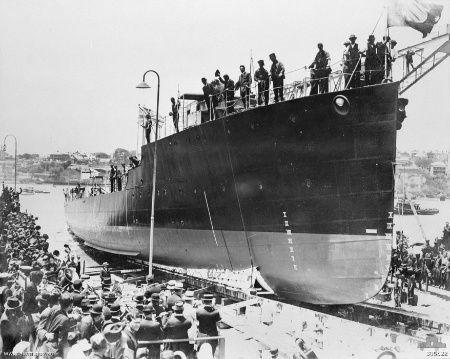
The launch of HMAS Swan, one of the three destroyers entirely made at Cockatoo.
HMAS Parramatta wa sbuilt at Fairfield Shipbuilding and Engineering Company Limited in Govan (Glasgow) whereas HMAS Yarra was from William Denny & Brothers in Dumbarton. Laid down on 9 April 1910 and completed in UK. HMAS Warrego was laid down at Fairfield Shipbuilding in Govanlike Parramatta but not assembled, all parts being shipped to Australia. The was the first destroyer and major warship ever built and completed at the newly established Cockatoo Dockyard in Sydney, on 4 April 1911. HMSA Huon, Swan and Torrens were then built in turn at Cockatoo. They were completed later in 1914-1915 as the yard learned its skills at the same time. This was one early example of technology transfer. A Town class cruiser was also built in Australia to lead them, HMAS Adelaide, but she was completed in the early 1920s.
 Parramatta
Parramatta
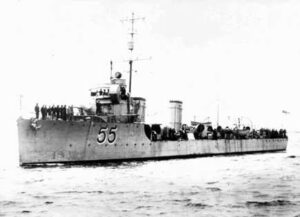 HMAS Parramatta was born at Fairfield Shipbuilding and Engineering Company Limited in Govan, Glasgow as a prototype for the serie. She was launched on 9 February 1910, first ship launched for the RAN and temporarily commissioned into the RN, the Australia when recommissioned on 1 March 1911 just as the RAN was created. She sailed to Melbourne with her sister for a gala welcome. On 4 October 1913, she made a formal fleet entry into Sydney with the battlecruiser HMAS Australia.
HMAS Parramatta was born at Fairfield Shipbuilding and Engineering Company Limited in Govan, Glasgow as a prototype for the serie. She was launched on 9 February 1910, first ship launched for the RAN and temporarily commissioned into the RN, the Australia when recommissioned on 1 March 1911 just as the RAN was created. She sailed to Melbourne with her sister for a gala welcome. On 4 October 1913, she made a formal fleet entry into Sydney with the battlecruiser HMAS Australia.
From 1914 to 1917, Parramatta patrolled the Pacific and South-East Asia. She was called HMS Parramatta until the HMAS prefix was approved on 10 July, by King George V and also granted permission for the Royal Australian Navy to exist separately.
In 1914 the RAN searched for the German East Asia Squadron, and trie to take German colonies in the South Pacific, notably New Guinea for a full Allied occupation (including Japan) of the former German Pacific empire. On 5 February 1915 Parramatta, Yarra and Warrego sailed for Australia for convoy escort until November. She was refitted at Sydney, and then patrolled Malaya, the East Indies and Philippines, back on 17 July 1916, home waters until 17 May 1917 and then ordered to Malta. She was transferred to the Mediterranean for escort work.
In fact all six River-class destroyers went through ASW training and escorts between Port Said and Malta. On 16 August her lookouts spotted a periscope and she dropped depth charges but made no kill. Next she patrolled the Adriatic and even used an observation balloon.
On 16 November 1917, Parramatta and sisters rescued men fril the Italian transport Orione, torpedoed. She towed her towards the mainland to beach her. Yarra meanwhile try to find the U-Boat. From 28 September 1918, Parramatta was refitted in Greece, Piraeus, and joined the Allies forces at Constantinople in October 1918 for the the surrender of Turkish forces. Her captain also accepted the surrender of a admiral Souchon, former German Mediterranean Squadron, former SMS Goeben, now Yavuz. She also made mail runs between Constantinople and Sevastopol in Russia and from December 1914 sailed to Devonport for an full overhaul starting on 14 January 1919.
She sailed back to Australia with her sisters and they ran out of fuel underway, on 26 April 1919, just a day out of Darwin. They were towed to port after signalling their presence.
She was back to Australia for little service in 1919, and placed in reserve until 1928. Retrospectively the would received the battl honours “Rabaul 1914” and “Adriatic 1917–18”.
From October 1924 until November 1925 however she was used as training vessel in Westernport, Victoria and moved to Sydney, then Adelaide, and back to to Sydney in April 1928. Fully decommissioned in 1928 she was stripped of parts and sold as prisoner accommodation on the Hawkesbury River until running aground during a gale in 1933 andleft to rust. In 1973, the bow and stern sections were salvaged, and converted into memorials. Her Bow and stern sections were salvaged and became memorials of the early RAN in 1973.
 Yarra
Yarra
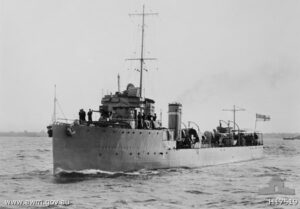 HMS Yarra was laid down in 1909, launched on 9 April 1910 and commissioned on 1 March 1911. She operated with the Australian fleet, looking for the German East Asia Squadron and taking part in the occupation of the German colonies in the South Pacific region, notably New Guinea. On 5 February 1915, with Parramatta, and Warrego she spent time off the coast of Austrlia in convoy escort duties until August. After a refit at Sydney, she sailed for the Far East and returned to Australia on 8 May 1916, patrolling home waters until May 1917, and followed her squadron to Malta.
HMS Yarra was laid down in 1909, launched on 9 April 1910 and commissioned on 1 March 1911. She operated with the Australian fleet, looking for the German East Asia Squadron and taking part in the occupation of the German colonies in the South Pacific region, notably New Guinea. On 5 February 1915, with Parramatta, and Warrego she spent time off the coast of Austrlia in convoy escort duties until August. After a refit at Sydney, she sailed for the Far East and returned to Australia on 8 May 1916, patrolling home waters until May 1917, and followed her squadron to Malta.
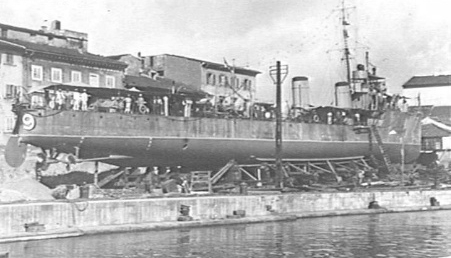
Yarra undergoing a drydocking at Livorno in 1917
After a solid ASW training she was deployed to Brindisi for patrols in the Adriatic. On 17 October 1918, she arrived in the Black Sea for suooport operaitons of the White Russians and was sent in UK for a full overhaul in early 1919. In 1920 she was attributed the battle honours “Rabaul 1914” and “Adriatic 1917–18”. She sailed back home on 6 March 1919 but with Parramatta she ran out of fuel ooff Darwin, was towed to port by HMAS Warrego. Placed into reserve she was recommissioned five times between 1919 and 1928, mosdlty for maintaining basic training of naval reservists. At last she was decommissoned on 30 September 1929 and stripped from parts at Cockatoo Island Dockyard before disposal and on 22 August 1932 her hulk was towed to sea, spent as target off Sydney.
 Warrego
Warrego
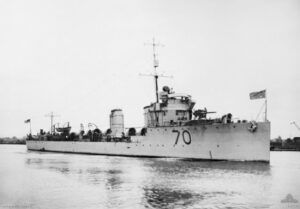 Initially she was ordered on 6 February 1909, the first ship to be ordered for the Commonwealth Naval Forces. She was also the first warship assembled in Australia. She was laid down indeed at Fairfield Shipbuilding and when reaching launch condition, she was disassembled after a cautions process with makings all over the place and schemes being prepared. Thus was the first time the yard delivered a destroyer “kit” ever (or any British yad for that matter). Parts were all craned up into a ships and transported to Australia. Then they were all landed and carefully re-laid and reassembled at Cockatoo Island Dockyard, in December 1910. The idea came from a joint-venture between the Yard sponsored by the Government to boost Australian shipbuilding standards. The brand new Cockatoo Island Yard was to be given enough experience in warship construction with this assembly, which was essentially reversed engineered. She was launched on 4 April 1911 with a grand ceremony, baptised by George Pearce’s wife, the then Minister for Defence of Austrlia. She was completed on 1 June 1912, commissioned the same day, named after the Warrego River.
Initially she was ordered on 6 February 1909, the first ship to be ordered for the Commonwealth Naval Forces. She was also the first warship assembled in Australia. She was laid down indeed at Fairfield Shipbuilding and when reaching launch condition, she was disassembled after a cautions process with makings all over the place and schemes being prepared. Thus was the first time the yard delivered a destroyer “kit” ever (or any British yad for that matter). Parts were all craned up into a ships and transported to Australia. Then they were all landed and carefully re-laid and reassembled at Cockatoo Island Dockyard, in December 1910. The idea came from a joint-venture between the Yard sponsored by the Government to boost Australian shipbuilding standards. The brand new Cockatoo Island Yard was to be given enough experience in warship construction with this assembly, which was essentially reversed engineered. She was launched on 4 April 1911 with a grand ceremony, baptised by George Pearce’s wife, the then Minister for Defence of Austrlia. She was completed on 1 June 1912, commissioned the same day, named after the Warrego River.
She started by operating in Australian waters in the same sauadron as Yarra and Parramatta. In 1914 she was assigned to the Australian forces tasked to neutralise German colonies and deal with the German East Asia Squadron.] On the night of 11 August 1914, Warrego and Yarra entered Simpson Harbour at Rabaul to try to provoke the Germans and lure them out at range of the the battlecruiser HMAS Australia. But the harbour was empty. The city was taken with ease. By late August and early September she escorted the Australian Naval and Military Expeditionary Force to New Britain and covered landings at Kabakaul and capture of a German wireless station. After a refit in Sydney, she returned to New Guinea until 5 February 1915, and returned for escorts along the east coast of Australia. By October, she sailed to Borneo for patrols until August 1916. In October 1917 all five River class were reassigned to the Mediterranean and she ended for ASW training at Brindisi, starting a few weeks after patrols in the Adriatic. HMAS Warrego thus took part in the Second Battle of Durazzo on 2 October 1918. She shelled the Austrian port. She made alos a brief deployment in the Black Sea and sailed to Gibraltar and UK for a short refit, then sailed for Australia with HMAS Melbourne, to Darwin on 26 March 1919. Warrego towed Parramatta and Yarra to port, both out of fuel. On 20 July she was placed in reserve, recommissioned in 1920 and March 1928 for training reservists. She was was paid off on 19 April 1928, stripped at Cockatoo Island in 1929, moored as an accommodation hulk but by 23 July 1931 she sank at berth and remains were blasted by demolition charges.
 Huon
Huon
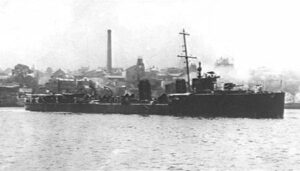 HMAS Huon was essentally the first modern, large warship built from the keel up at Cockatoo shipyard. She was indeed laid down at Cockatoo on 25 January 1913 and launched on 19 December 1914 and commissioned on 14 December 1915, but only officially completed on 4 February 1916. The delaybefore the laying down was due to the sum of documentation and experience from assembling her sister HMAS Warrego, about a year delay. She was originally to be named HMAS Derwent but changed to avoid any confusion with HMS Derwent.
HMAS Huon was essentally the first modern, large warship built from the keel up at Cockatoo shipyard. She was indeed laid down at Cockatoo on 25 January 1913 and launched on 19 December 1914 and commissioned on 14 December 1915, but only officially completed on 4 February 1916. The delaybefore the laying down was due to the sum of documentation and experience from assembling her sister HMAS Warrego, about a year delay. She was originally to be named HMAS Derwent but changed to avoid any confusion with HMS Derwent.
Huon was part of the British Far East Patrol based at Sandakan in 1916 and later Singapore from June 1916 to May 1917 and by 7 July she met her sisters at Cocos Islands before proceeding to Malta and the Mediterranean via Diego Garcia. Huon escorted ships from Port Said to Malta before having a refit.
From October 1917 to April 1918 after extra ASWtraining she was sent to the Adriatic patorl based at Brindisi. She had another refit from 17 April to 16 May in Malta. On 9 August 1918 in the Straits of Otranto by poor visibility she collided with her sister HMAS Yarra and sent to Genoa for repairs. In drydock the crew was hit badly by the 1918 flu pandemic with four stokers and a lieutenant dying from influenza. She left the dock one day before the war ended. After travelling to Portsmouth, and another refit on 14 January 1919 she proceeded from the 28th to HMAS Melbourne for the voyage back to Australia, reaching Sydney on 21 May. She was placed in reserve, then recommissioned at Sydney on 1 August 1919 for local waters training and escorting the battlecruiser HMS Renown visiting Austrlia with the Prince of Wales in 1920. She was in reserve again from August 1920 to 22 April 1921 and while training on 9 February 1922, she was holed below the waterline in a collision with HMAS J4. After another reserve she was recommissioned on 29 August 1925 for reservist training at Hobart, until 26 May 1928, sent to Sydney, decommissioned on 7 June 1928. On 10 April 1931 she was towed and used at sea as gunnery target ship. She as fired at by HMAS Australia, Canberra, Anzac, and Albatross, and eventualy scuttled.
 Swan
Swan
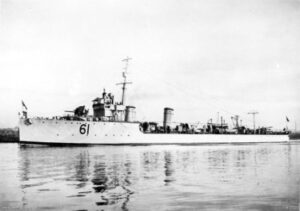 Second destroyer entirely built at Cockatoo Yard, Sawn was laid down on 22 January 1913, launched on 11 December 1915 and commissioned on 16 August 1916. She took part in the British blockade forces in the the Philippines, Celebes and Malaya. On 2 July 1917 she joined her squadron and proceeded to the Mediterranean, Malta, then Brindisi after ASW training. Patrols were uneventful. She joined the shore bombardments party at the Second Battle of Durazzo on 2 October 1918.On 25 October she sailed for Port Said to meet a troop transport convoy and relieved their Japanese escort, then proceeded to Salonika.
Second destroyer entirely built at Cockatoo Yard, Sawn was laid down on 22 January 1913, launched on 11 December 1915 and commissioned on 16 August 1916. She took part in the British blockade forces in the the Philippines, Celebes and Malaya. On 2 July 1917 she joined her squadron and proceeded to the Mediterranean, Malta, then Brindisi after ASW training. Patrols were uneventful. She joined the shore bombardments party at the Second Battle of Durazzo on 2 October 1918.On 25 October she sailed for Port Said to meet a troop transport convoy and relieved their Japanese escort, then proceeded to Salonika.
She proceeded postwar to the Black sea, joining the Allied fleet taking over Russian anti-Bolshevik vessels present in Sebastopol. In December she joined the French destroyer Bisson to eastern Ukraine, and report an advance by Bolshevik forces. Next she sailed to Gibraltar and was prepared for the trip back to Australia led by HMAS Melbourne on 3 January 1919. While there she operated until June 1920, placed in reserve until 1925, sent to Tasmania for training and reserve until paid off at Sydney on 15 May 1928, sold for scrapping in 1930. After being stripped down she ended as a floating prison for the South Wales Penal Department at Cowan Creek. Conditions aboard were however appealing and after Public outcry the hulks were sold in 1933 for just 12 pounds to a Cowan firm as accommodation for fisher and later to transport blue metal. By 2 February 1934, Swan and Parramatta were to be BU at Sydney but they were caught while towed en route by a gale, breaking their tows. Parramatta ran aground, Swan capsized near Croppy Point. She was rediscovered in 1994 by diver Greig Berry.
 Torrens
Torrens
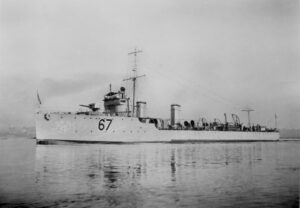 HMAS Torrens was the last Austrlian destroyers built as part of the River class. She was laid down on 25 January 1913, launched on 28 August 1915 and commissioned on 3 July 1916, named after a River in South Australia. With her sister HMAS Swan she as assigned to the British Far East Patrol. From September 1916 to May 1917 she stayed in the area and by June, entered Singapore for a refit after which she met the rest of the RAN squadron sailing for the Mediterranean. She escorted a convoy from Port Said to Malta, had a new refit, ASW training, before departing to Brindisi, cut by another refit in Malta by December. On the the night of 22–23 April 1917, she was attacked by five Austrian destroyers which hit the British destroyers HMS Hornet and Jackal (Acheron class) before retreating. HMAS Torrens was not fast enough to caught them. She had a refit at Messina and stayed on patrol until November 1918 after which she returned to Australia in May 1919, and after routine duties was paid off into reserve on 19 July 1920, then moved to Flinders Naval Depot in July 1924, training of naval reservists. Next she was at Port Adelaide, used for training until March 1925 and back to Sydney on 11 May for the same. The post-1929 conditions imposed budget restruction and she was scheduled for crapping, stripped and by 24 November 1930, towed off Sydney Heads, used for gunnery target practice and after a battering, scuttled with gelignite.
HMAS Torrens was the last Austrlian destroyers built as part of the River class. She was laid down on 25 January 1913, launched on 28 August 1915 and commissioned on 3 July 1916, named after a River in South Australia. With her sister HMAS Swan she as assigned to the British Far East Patrol. From September 1916 to May 1917 she stayed in the area and by June, entered Singapore for a refit after which she met the rest of the RAN squadron sailing for the Mediterranean. She escorted a convoy from Port Said to Malta, had a new refit, ASW training, before departing to Brindisi, cut by another refit in Malta by December. On the the night of 22–23 April 1917, she was attacked by five Austrian destroyers which hit the British destroyers HMS Hornet and Jackal (Acheron class) before retreating. HMAS Torrens was not fast enough to caught them. She had a refit at Messina and stayed on patrol until November 1918 after which she returned to Australia in May 1919, and after routine duties was paid off into reserve on 19 July 1920, then moved to Flinders Naval Depot in July 1924, training of naval reservists. Next she was at Port Adelaide, used for training until March 1925 and back to Sydney on 11 May for the same. The post-1929 conditions imposed budget restruction and she was scheduled for crapping, stripped and by 24 November 1930, towed off Sydney Heads, used for gunnery target practice and after a battering, scuttled with gelignite.
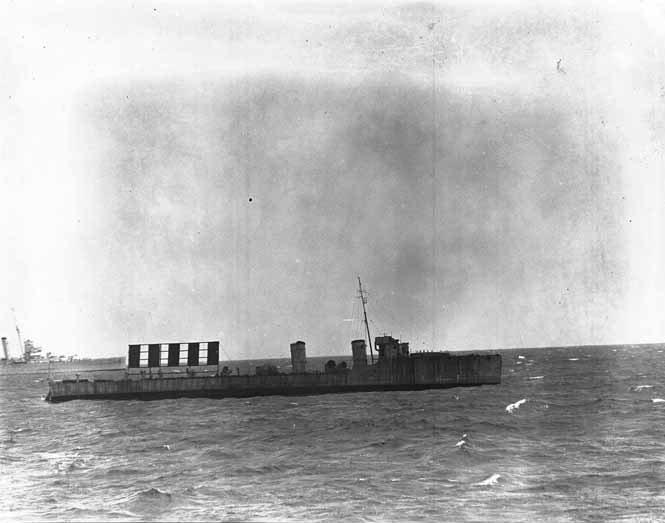
HMAS Torrens sunk as target on 24 November. She got a battering by several first rank warships and heavy cruisers, before being scuttled with explosive charges.
Career of the Acheron class
 HMS Acheron
HMS Acheron
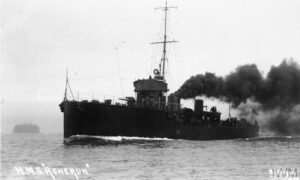 HMS Acheron was launched on 27 June 1911. She was in the 1st Destroyer Flotilla, Grand Fleet in 1914. She fought at the Battle of Heligoland Bight on 28 August 1914 with her flotilla, led by the light cruiser HMS Fearless. On 24 January 1915 the also took part in the present at the Battle of Dogger Bank, led by HMS Aurora. On 10 March 1915 while underway with HMS Attack and Ariel, she was lookng for a sub spotted by the trawler Man Island near Aberdeen. At 10:10 am Attack sighted U-12 surfaced and opened fire, then Ariel sighted her at 10:12 am, 2 nautical miles (3.7 km) from the others.
HMS Acheron was launched on 27 June 1911. She was in the 1st Destroyer Flotilla, Grand Fleet in 1914. She fought at the Battle of Heligoland Bight on 28 August 1914 with her flotilla, led by the light cruiser HMS Fearless. On 24 January 1915 the also took part in the present at the Battle of Dogger Bank, led by HMS Aurora. On 10 March 1915 while underway with HMS Attack and Ariel, she was lookng for a sub spotted by the trawler Man Island near Aberdeen. At 10:10 am Attack sighted U-12 surfaced and opened fire, then Ariel sighted her at 10:12 am, 2 nautical miles (3.7 km) from the others.
U-12 plunged at kept periscope depth as Ariel manoeuvered for ramming at 200 yards (180 m), aiming for her conning tower and managed to hit her. Badly damaged, she surface for the crew to escape, but the hatch was jammed, so there were less survivors, escape via the other hatches. Acheron at first fired on U-12 when she surfaced and killed some escaping sailors. At 10:30 am she picked up a few of the 10 survivors. Ariel needed her bow repaired, towed into port. On 31 May 1916 still with her flotilla she took part in the Battle of Jutland. From 1917 as part of the 3rd Battle Squadron she was sent to the Mediterranean and present when the Allied fleet entered the Dardanelles on 12 November 1918. She was sold for BU on 9 May 1921, then 1923.
 HMS Archer
HMS Archer
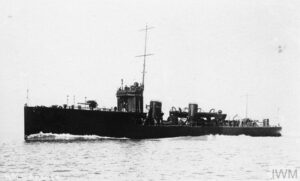 HMS Archer was laid down on 1 September 1910, launched on 21 October 1911 and commissioned by March 1912. She was the 4th of the name in the RN and ordered under the 1910–1911 Naval Programme at Yarrow & Company. No records prior to 1914, but she presumably integrated the 1st battle squadron, so her records should be the same as HMS Acheron. From ther, she joined like her sister ships the 3rd Battle Squadron deployed to the Mediterranean. She entered the Dardannelles with the Allied fleet on 12 November 1918 and was was sold for BU on 9 May 1921.
HMS Archer was laid down on 1 September 1910, launched on 21 October 1911 and commissioned by March 1912. She was the 4th of the name in the RN and ordered under the 1910–1911 Naval Programme at Yarrow & Company. No records prior to 1914, but she presumably integrated the 1st battle squadron, so her records should be the same as HMS Acheron. From ther, she joined like her sister ships the 3rd Battle Squadron deployed to the Mediterranean. She entered the Dardannelles with the Allied fleet on 12 November 1918 and was was sold for BU on 9 May 1921.
 HMS Ariel
HMS Ariel
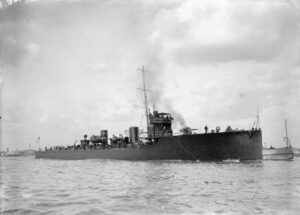 Launched on 26 September 1911, HMS Ariel (H11 1915, H37 1916-17, H07 in 1918) was part of the First Destroyer Flotilla, Grand Fleet in 1914, and then the 3rd Battle Squadron from from May 1916. She was converted as a minelayer in 1917 and versed with the 20th Flotilla.
Launched on 26 September 1911, HMS Ariel (H11 1915, H37 1916-17, H07 in 1918) was part of the First Destroyer Flotilla, Grand Fleet in 1914, and then the 3rd Battle Squadron from from May 1916. She was converted as a minelayer in 1917 and versed with the 20th Flotilla.
On 5 August 1914, she towed submarine E8 to Terschelling with the cruiser Amethyst and submarine E6 for their first Heligoland Bight patrol. As part of the Harwich Force she took part in the Battle of Heligoland Bight under Captain Dashwood Moir and 24 January 1915, the Battle of Dogger Ban wit the lead cruise being the first British ship to engage the Germans at 07:05.
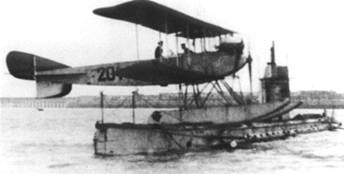 On 10 March as seen above with Acheron, Ariel sailed with hms Attack to try to catch an U-Boat spotted by the trawler Man Island off Aberdeen. Attack sighted U-12 first, opened fire and Ariel, at the time under Captain Lt Cdr J V Creagh sighted U-12 in turn at 10:12, 2 nmi (3.7 km; 2.3 mi) away, and when U-12 dived, raised periscope, she re-spotted her at 200 yd (180 m) and manoeuvered to to ram, aming at her conning tower. This was a hit. She muched badly her bow, but “decapitated” U-12’s sail and jammed her scape hatch. The few survivors had to go through other hatches and only 10 were picked upo before she sank. After this, she had to be towed into port.
On 10 March as seen above with Acheron, Ariel sailed with hms Attack to try to catch an U-Boat spotted by the trawler Man Island off Aberdeen. Attack sighted U-12 first, opened fire and Ariel, at the time under Captain Lt Cdr J V Creagh sighted U-12 in turn at 10:12, 2 nmi (3.7 km; 2.3 mi) away, and when U-12 dived, raised periscope, she re-spotted her at 200 yd (180 m) and manoeuvered to to ram, aming at her conning tower. This was a hit. She muched badly her bow, but “decapitated” U-12’s sail and jammed her scape hatch. The few survivors had to go through other hatches and only 10 were picked upo before she sank. After this, she had to be towed into port.
She also took part in the Battle of Jutland on 31 May 1916 under Lieutenant Cdt. Tippet, 1st Destroyer Flotilla, HMS Fearless. On 6 December 1916, UC-19 sank the Russian sailing ship And and the nearby P&O Kashmir set a radio warning. Ariel rushed on the scene and patrolled until her lookouts spotted a conning tower. UC-19 made a crash dive and Ariel dropped a depth charge, a dud. Caotain Tippet then ordered to use the newly installed explosive paravane. There was a detonation under 30 ft (9.1 m) with a pool of oil and bubbles observed. This was registered as a kill and confirmed postwar. UC-19 sank with 25 sailors, under 330 ft (100 m).
In 1917, Ferret, Sandfly and Ariel were converted to minelaying destroyers, with rails for 40 mines, and she integrated the 20th Flotilla based in Immingham. She was soon mobilizzed for the larget minelaying operation of WW1, using H2-pattern mines, to close the Heligoland Bight to German ships and submarines. On 27 March 1918 while laying one 70 nmi (81 mi; 130 km) NW of Heligoland she captured the German trawlers, Polarstern, Mars and Scharbentz. On 2 August she was laying mines at the western end of the Heligoland Bight, when HMS Vehement sank after striking a German mine. Ariel tried to extract herself from this newly found minefield by lost her bow and sank after hitting one. She went down with 49 people, including the captain Lt. Frank A Rothera.
 HMS Attack
HMS Attack
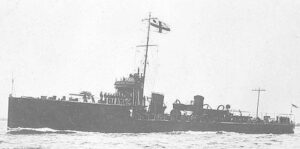 HMS Attack (H14, H86) was Launched on 12 December 1911 and commissioned in May 1912 with the 1st Destroyer Flotilla, Grand Fleet in 1914, took part in the Battle of Heligoland Bight and Dogger Bank on 24 January 1915 under Lt. Cdr Cyril Callaghan, assisting the damaged battlecruiser Lion and hosting Vice Admiral Beatty from 11:34, then she rushed to rejoin the rest of the battlecruisers and made it to HMS Princess Royal at 12:20. On 10 March 1915 wuth Ariel and Acheron she was present in the sinking of U-12. She also took part in the Battle of Jutland under Lt Cdr C H N James. By 8 August 1917, she assisted the Q-ship Dunraven seriously damaged after a skirmish with UC-71. She sank at 01:30 on 10 August 1917 and Attack rescued survivors. Next her unit was sent to the Mediterranean, now the 3rd flotilla.
HMS Attack (H14, H86) was Launched on 12 December 1911 and commissioned in May 1912 with the 1st Destroyer Flotilla, Grand Fleet in 1914, took part in the Battle of Heligoland Bight and Dogger Bank on 24 January 1915 under Lt. Cdr Cyril Callaghan, assisting the damaged battlecruiser Lion and hosting Vice Admiral Beatty from 11:34, then she rushed to rejoin the rest of the battlecruisers and made it to HMS Princess Royal at 12:20. On 10 March 1915 wuth Ariel and Acheron she was present in the sinking of U-12. She also took part in the Battle of Jutland under Lt Cdr C H N James. By 8 August 1917, she assisted the Q-ship Dunraven seriously damaged after a skirmish with UC-71. She sank at 01:30 on 10 August 1917 and Attack rescued survivors. Next her unit was sent to the Mediterranean, now the 3rd flotilla.
On 27 December 1917 with two IJN destroyers she escorted the two transport ships HMT Aragon and SS Nile, to Egypt. They crossed a gale and later split on 30 December with Nile and the two IJN destroyers sailing for to Port Said, Aragon and Attack for Alexandria. But while underway in Alexandria Roads just 8 miles for the port and while Aragon awaiting permission to enter she was torpeded by The UC II class SM UC-34 and sank rapidly. HMT Points Castle and Attack rushed for rescue. Later Aragon suffered another explition and went down. Attack managed to pick up 300 to 400 survivors, when she receoved a torpedo hit amidships whuch cut her in two, sinking in seven minutes. Her ruptured bunkers spilled tons of black bunker fuel oil and hundreds of men ended covered in oil or die by asphyxiation. Aragon’s surviving lifeboats ferried hundreds of swimming or hanging survivors to arriving trawlers. In all, 600 men frop Aragon and most of her own crew went down.
 HMS Badger
HMS Badger
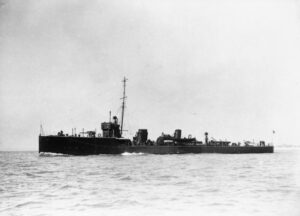 HMS Badger was launched on 11 July 1911. 1st Destroyer Flotilla from 1911, Grand Fleet in 1914, Battle of Heligoland Bight on 28 August 1914 with Jackal, Beaver and Sandfly. (She shared the prize money for the engagement). On 24 October 1914 she became the first Allied ship to ram an U-boat when off the Dutch coast. The latter though limped back to port for repairs, surviving the war.
HMS Badger was launched on 11 July 1911. 1st Destroyer Flotilla from 1911, Grand Fleet in 1914, Battle of Heligoland Bight on 28 August 1914 with Jackal, Beaver and Sandfly. (She shared the prize money for the engagement). On 24 October 1914 she became the first Allied ship to ram an U-boat when off the Dutch coast. The latter though limped back to port for repairs, surviving the war.
She took part in the Battle of Jutland under C A Fremantle, and she was the first destroyer to rescue the crew of HMS Invincible, crippled after a magazine explosion. She manage to recuperate only two officers and four crew that day. On 17 April 1917 at 7:30 PM the French liner SS Lanfranc was torpedoed 4 miles NE of Le Havre by UB-40. She was due to Southampton working as an hosptal ship with British wounded men, 387 patients, but also 167 were German POW. 326 of the patients were cot-bound and still 570 survivors were picked up by Badger and Jackal with HMS P47 and the French patrol boat Roitelet, brought to Portsmouth. Later under Lt.Cdr Geoffrey Corlett she served in the Mediterranean. She took part in shelling missions off Durazzo and her captain received the Italian Naval Decoration for service.
On 4 February 1918 Bagder departed, escorting convoy HX-20 with seven other destroyers from Northern Ireland. At 6:45 PM while through the North Channel, SS Tuscania (14,348 GRT) was torpedoed by UB-77, packed with US soldiers. 210 went down with her. The rest were resued by the destroyers. She was laid up and by May 1921, sold for BU.
 HMS Beaver
HMS Beaver
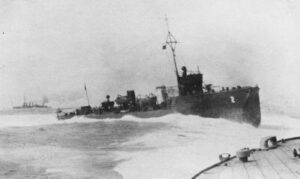 HMS Beaver was laid down on 6 October 1910, launched on 6 October 1911 and commissioned in November 1912. Her career in short: 1st Destroyer Flotilla from 1911, Great Yarmouth in December 1912, British Grand Fleet in 1914, Battle of Heligoland Bight with Jackal, Badger and Sandfly with prize money. She patrolling the English Channel to the Hook of Holland, escorted hospital ships to and from France at the time many wounded men were treated in Britain. She reported contact and an action against an unknown U-Boat but no kill.
HMS Beaver was laid down on 6 October 1910, launched on 6 October 1911 and commissioned in November 1912. Her career in short: 1st Destroyer Flotilla from 1911, Great Yarmouth in December 1912, British Grand Fleet in 1914, Battle of Heligoland Bight with Jackal, Badger and Sandfly with prize money. She patrolling the English Channel to the Hook of Holland, escorted hospital ships to and from France at the time many wounded men were treated in Britain. She reported contact and an action against an unknown U-Boat but no kill.
In April 1918 she was sent to the Mediterranean, still for convoy and ASW work based at Brindisi, taking also part the Otranto blockade in the Adriatic. In October 1918 she took part in the bombardment of Durazzo. After the Armistice of Mudros she ferried troops to the Dardanelles, enteed the Sea of Marmaraand then Constantinople, then Odessa, with an occupation by the Germans and White Russian Army. She even entered up the Danube and by December 1918 visited Sevastopol to inspect the remnants of the Russian Black Sea Fleet lay, also picking up political refugees from Odessa. Back home, she laid up and by May 1921, sold for BU.
 HMS Defender
HMS Defender
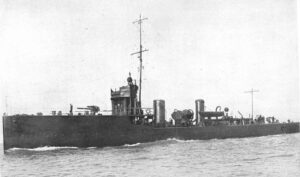 HMS Defender (H28, 29) was an admiralty class design laid down at William Denny & Brothers in Dumbarton, Scotland on 7 November 1910, launched on 30 August 1911, completed in January 1912 at a cost of £83,000, part of the 1st Destroyer Flotilla, Grand Fleet in 1914 which took part in the Battle of Heligoland Bight and picked up survivors from the German DD SMS V187 until SMS Stettin appeared. They would be later picked up by HMS E4. On 23 November 1914 she was part of Harwhich Force during the Russell and Exmouth raid on Zeebrugge, joining forces with the Dover Patrol and four French destroyers. Next she took part in the Battle of Dogger Bank led by Aurora and later the Battle of Jutland supporting Beatty’s battlecruiser force. At 18:30 she took a heavy shell (12 inches/305 mm) hit in her forward boiler room, killing 1, wounding 2, despite the shell was a dud. She slowed to 15 knots and fell out of formation until restoring power and taking HMS Onslow in tow towards Aberdeen which earned Lieutenant Commander L R Palmer a DSO. This was described in detail by Rudyard Kipling and commented by Admiral Beatty. She wa slater reassigned to the mediterranean.
HMS Defender (H28, 29) was an admiralty class design laid down at William Denny & Brothers in Dumbarton, Scotland on 7 November 1910, launched on 30 August 1911, completed in January 1912 at a cost of £83,000, part of the 1st Destroyer Flotilla, Grand Fleet in 1914 which took part in the Battle of Heligoland Bight and picked up survivors from the German DD SMS V187 until SMS Stettin appeared. They would be later picked up by HMS E4. On 23 November 1914 she was part of Harwhich Force during the Russell and Exmouth raid on Zeebrugge, joining forces with the Dover Patrol and four French destroyers. Next she took part in the Battle of Dogger Bank led by Aurora and later the Battle of Jutland supporting Beatty’s battlecruiser force. At 18:30 she took a heavy shell (12 inches/305 mm) hit in her forward boiler room, killing 1, wounding 2, despite the shell was a dud. She slowed to 15 knots and fell out of formation until restoring power and taking HMS Onslow in tow towards Aberdeen which earned Lieutenant Commander L R Palmer a DSO. This was described in detail by Rudyard Kipling and commented by Admiral Beatty. She wa slater reassigned to the mediterranean.
On 18 June 1918, HMS Defender was in the Strait of Otranto with HMS Nymphe when attacked by the sub chasers USS SC-95, USS SC-151, and USS SC-227 guided by their hydrophones, challenging the destroyers by blinker light with no answer. Defender later took Nymphe, crippled, under tow. Back home she was laid up and sold on 4 November 1921.
 HMS Druid
HMS Druid
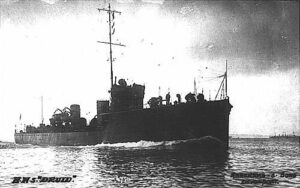 HMS Druid (H33, 30, 92) was laid down at William Denny & Bros, Dumbarton on 8 November 1910, launched on 4 December 1911, commissioned in April 1912. With the 1st Destroyer Flotilla she took part in the Battle of Heligoland Bight led by Fearless, and Dogger Bank led by Aurora. She was part of those attacking and sinking Blücher. In 1917 the now part of the 3rd Battle Squadronshe was reassigned to the Mediterranean and like her sisters entered the Dardanelles on 12 November 1918. She was laid up after the war and on 9 May 1921 sold for BU.
HMS Druid (H33, 30, 92) was laid down at William Denny & Bros, Dumbarton on 8 November 1910, launched on 4 December 1911, commissioned in April 1912. With the 1st Destroyer Flotilla she took part in the Battle of Heligoland Bight led by Fearless, and Dogger Bank led by Aurora. She was part of those attacking and sinking Blücher. In 1917 the now part of the 3rd Battle Squadronshe was reassigned to the Mediterranean and like her sisters entered the Dardanelles on 12 November 1918. She was laid up after the war and on 9 May 1921 sold for BU.
 HMS Ferret
HMS Ferret
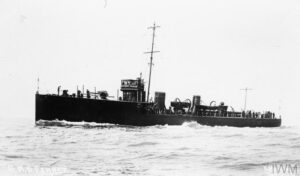 HMS ferret (H35, 32, 93) was laid down at J. Samuel White Yard and launched on 12 April 1911, attached to the 1st Destroyer Flotilla then Grand Fleet in 1914, took part in the Battle of Heligoland Bight, Battle of Jutland and by November 1916 entered the 3rd Battle Squadron. On 18 January 1917 she was torpedoed by UC 21 SE of St. Catherine’s Point (1 killed) but she was not fatally damaged, managed to get back home, be repaired and returned to service. In 1917 with Sandfly and Ariel she was converted as minelaying destroyer with rails for 40 mines and serve with the 7th Flotilla on the East Coast by July, then 20th Flotilla in March 1918 from Immingham. She was deployed for a minelaying operation to close Heligoland Bight but in the night of 27/28 March 1918 while 70 nm (130 km) NW of the island she fell on three armed German trawlers, sinking them with her sisters, taking 72 POWs. Laid up postwar she was sold on 9 May 1921.
HMS ferret (H35, 32, 93) was laid down at J. Samuel White Yard and launched on 12 April 1911, attached to the 1st Destroyer Flotilla then Grand Fleet in 1914, took part in the Battle of Heligoland Bight, Battle of Jutland and by November 1916 entered the 3rd Battle Squadron. On 18 January 1917 she was torpedoed by UC 21 SE of St. Catherine’s Point (1 killed) but she was not fatally damaged, managed to get back home, be repaired and returned to service. In 1917 with Sandfly and Ariel she was converted as minelaying destroyer with rails for 40 mines and serve with the 7th Flotilla on the East Coast by July, then 20th Flotilla in March 1918 from Immingham. She was deployed for a minelaying operation to close Heligoland Bight but in the night of 27/28 March 1918 while 70 nm (130 km) NW of the island she fell on three armed German trawlers, sinking them with her sisters, taking 72 POWs. Laid up postwar she was sold on 9 May 1921.
 HMS Forester
HMS Forester
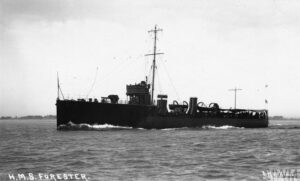 HMS Forester was a 30 knots DD built at Samuel White, Cowes, launched on 1 June 1911 (H39, H34, H58), attached to 1st Destroyer Flotilla and Grand Fleet in 1914, taking part in the Battle of Heligoland Bight, Battle of Dogger Bank, missing Jutland on 31 May 1916 and transferred to 3rd Battle Squadron in November 1916. When on 18 February 1917 off Portland Bill in the Channel HMAT Berrima hit a mine the made it into lifeboats later picked up by Forester which take the crippled ship under tow to Portland Harbour. She was reassigned to the Mediterranean but had no particular feat of note. She was present with the crossing the Dardanelles on 12 November 1918 and headed for Constantinople. Laid up postwar she was sold for BU on 4 November 1921.
HMS Forester was a 30 knots DD built at Samuel White, Cowes, launched on 1 June 1911 (H39, H34, H58), attached to 1st Destroyer Flotilla and Grand Fleet in 1914, taking part in the Battle of Heligoland Bight, Battle of Dogger Bank, missing Jutland on 31 May 1916 and transferred to 3rd Battle Squadron in November 1916. When on 18 February 1917 off Portland Bill in the Channel HMAT Berrima hit a mine the made it into lifeboats later picked up by Forester which take the crippled ship under tow to Portland Harbour. She was reassigned to the Mediterranean but had no particular feat of note. She was present with the crossing the Dardanelles on 12 November 1918 and headed for Constantinople. Laid up postwar she was sold for BU on 4 November 1921.
 HMS Goshawk
HMS Goshawk
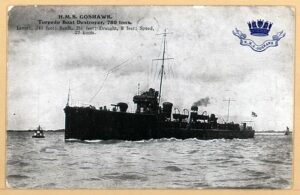 HMS Goshawk was built by William Beardmore of Dalmuir, launched on 18 October 1911, to standard Admiralty I-class design (H45, H37, H59), part of the 1st Destroyer Flotilla, grand fleet whe she engaged an enemy cruiser off the mouth of the Elbe in poor visibility. She escape destruction and reportd some hits. She took part on the Battle of Heligoland Bight and Commodore Tyrwhitt noted captain Herbert Meade, leading his group to sink the German Destroyer V187, and pick up survivors. She also took part later in the Battle of Dogger Bank and by 1915 was part of the submarine screen for the Grand Fleet’s battlecruisers (Beatty), moving from Harwich to the Firth of Forth from 17 March 1915. She took part in the Battle of Jutland and Commander Dashwood Fowler Moir was in turn mentioned in despatches. She was reassigned to the Mediterranean and was in Constantinople on 13 November 1918. Laid up popstwar she was sold for BU on 4 November 1921.
HMS Goshawk was built by William Beardmore of Dalmuir, launched on 18 October 1911, to standard Admiralty I-class design (H45, H37, H59), part of the 1st Destroyer Flotilla, grand fleet whe she engaged an enemy cruiser off the mouth of the Elbe in poor visibility. She escape destruction and reportd some hits. She took part on the Battle of Heligoland Bight and Commodore Tyrwhitt noted captain Herbert Meade, leading his group to sink the German Destroyer V187, and pick up survivors. She also took part later in the Battle of Dogger Bank and by 1915 was part of the submarine screen for the Grand Fleet’s battlecruisers (Beatty), moving from Harwich to the Firth of Forth from 17 March 1915. She took part in the Battle of Jutland and Commander Dashwood Fowler Moir was in turn mentioned in despatches. She was reassigned to the Mediterranean and was in Constantinople on 13 November 1918. Laid up popstwar she was sold for BU on 4 November 1921.
 HMS Hind
HMS Hind
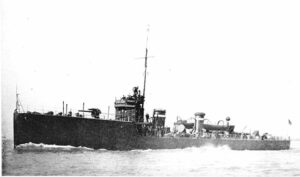 HMS Hind was built by John Brown together with Hornet and Hydra as a two shafts variant with Brown-Curtis type turbines and 28 knots, launched on 28 July 1911 (H47, H40, H60), she was assigned to the 1st Destroyer Flotilla, Grand Fleet in 1914, took part in the Battle of Heligoland Bight, missed the Battle of Jutland and was reassigned to the 3rd Battle Squadron in November 1916., the started a Mediterranean campaign in 1917 notably in the Adriatic, Otranto Barrage. She was present in Dardanelles on 12 November 1918, laid up postwar, sold 9 May 1921 for BU, scrapped in 1924.
HMS Hind was built by John Brown together with Hornet and Hydra as a two shafts variant with Brown-Curtis type turbines and 28 knots, launched on 28 July 1911 (H47, H40, H60), she was assigned to the 1st Destroyer Flotilla, Grand Fleet in 1914, took part in the Battle of Heligoland Bight, missed the Battle of Jutland and was reassigned to the 3rd Battle Squadron in November 1916., the started a Mediterranean campaign in 1917 notably in the Adriatic, Otranto Barrage. She was present in Dardanelles on 12 November 1918, laid up postwar, sold 9 May 1921 for BU, scrapped in 1924.
 HMS Hornet
HMS Hornet
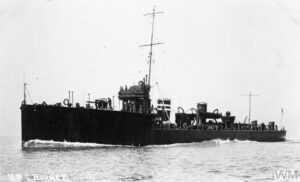 She was built by John Brown with Hind and Hydra as a sub-class, launched on 20 December 1911 (H49, H42, H08) and assigned to 1rst Destroyer Flotilla, then Grand Fleet in 1914, was present at the Battle of Dogger Bank, and when HMS Argyll ran aground on Bell Rock near Dundee (28 October 1914), Hornet and Jackal were sent to assist her, rescuing 650, the full crew. She missed the Battle of Jutland and joined the 3rd Battle Squadron byn November 1916, deployed next year in the Mediterranean, Otranto Barrage patrol. She was part of the battle on the night of 22–23 April 1918 when the Austro-Hungarian destroyers opened fire on her, she turned away making smoke but took a hit in her forward shell room and magazine, with a fire and explosion while the bridge and tiller flat were also hit, her rudder jammed hard over to starboard. She kept on circling under fire until after 15 minutes of pure hell, SMS Triglav broke off chased off by Jackal. She lost her mainmast in the engagement. On board Hornet there 4 killed and 25 wounded. Taken in two and repairs she was also present in the Dardanelles on 12 November 1918. laid up postwar she was sold on 9 May 1921.
She was built by John Brown with Hind and Hydra as a sub-class, launched on 20 December 1911 (H49, H42, H08) and assigned to 1rst Destroyer Flotilla, then Grand Fleet in 1914, was present at the Battle of Dogger Bank, and when HMS Argyll ran aground on Bell Rock near Dundee (28 October 1914), Hornet and Jackal were sent to assist her, rescuing 650, the full crew. She missed the Battle of Jutland and joined the 3rd Battle Squadron byn November 1916, deployed next year in the Mediterranean, Otranto Barrage patrol. She was part of the battle on the night of 22–23 April 1918 when the Austro-Hungarian destroyers opened fire on her, she turned away making smoke but took a hit in her forward shell room and magazine, with a fire and explosion while the bridge and tiller flat were also hit, her rudder jammed hard over to starboard. She kept on circling under fire until after 15 minutes of pure hell, SMS Triglav broke off chased off by Jackal. She lost her mainmast in the engagement. On board Hornet there 4 killed and 25 wounded. Taken in two and repairs she was also present in the Dardanelles on 12 November 1918. laid up postwar she was sold on 9 May 1921.
 HMS Hydra
HMS Hydra
 HMS Hydra (H50, H43, H94) was from John Brown & Company, laid down on 7 February 1911, launched on 19 February 1912 and commissioned in June the same year, attacjed to the 1st Destroyer Flotilla and taking part in the Battle of Dogger Bank and Battle of Jutland. She wa stransferred to the 3rd Battle Squadron at Portsmouth but collided with a merchant ship on 11 February 1917 in the Channel. The captain was blamed for not realizing he was not staying in his course. She was repaired and later reassigned to the Medditerranean in 1917, being present in the Dardanelles on 12 November 1918. On 9 February 1921 she collided with HMS Z3 in the Weilingen Channel and the latter sank but all 72 of her crew were rescued. She was sold for BU on 9 May 1921.
HMS Hydra (H50, H43, H94) was from John Brown & Company, laid down on 7 February 1911, launched on 19 February 1912 and commissioned in June the same year, attacjed to the 1st Destroyer Flotilla and taking part in the Battle of Dogger Bank and Battle of Jutland. She wa stransferred to the 3rd Battle Squadron at Portsmouth but collided with a merchant ship on 11 February 1917 in the Channel. The captain was blamed for not realizing he was not staying in his course. She was repaired and later reassigned to the Medditerranean in 1917, being present in the Dardanelles on 12 November 1918. On 9 February 1921 she collided with HMS Z3 in the Weilingen Channel and the latter sank but all 72 of her crew were rescued. She was sold for BU on 9 May 1921.
 HMS Jackal
HMS Jackal
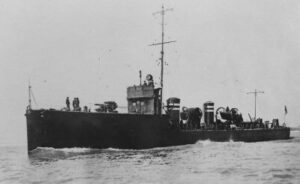 Jackal was built by R. W. Hawthorn Leslie (Admiralty design), launched on 9 September 1911 (H55, 44, 95).
Jackal was built by R. W. Hawthorn Leslie (Admiralty design), launched on 9 September 1911 (H55, 44, 95).
1st Destroyer Flotilla and Grand Fleet in 1914, took part in the Battle of Heligoland Bight, detached with Badger, Beaver and Sandfly and Dogger Bak on 24 January 1915, but also assisted the grounded cruiser HMS cruiser Argyll on 28 October and then survivors of the torpedoed liner SS Lanfranc on 17 April 1917. In 1917 as part of the 3rd Battle Squadron she was sent to the Mediterranean, taking part in the Adriatic, Otranto Barrage campaign and the night battle of 22–23 April 1918 with Tátra-class destroyers. Under Lieutenant-Commander A M Roberts she engaged Triglav until she broke off the engagement, and continued the pursuit but lost them. Jackal lost her mainmast in the fight had had 2 dead and about 10 wounded. They were later commended to have been able to drive off the best and latest enemy destroyers in the Adriatic. She also was present in Dardanelles on 12 November and Constantinople on the 13th. Laid up postwar she was sold for BU on 28 September 1920.
 HMS Lapwing
HMS Lapwing
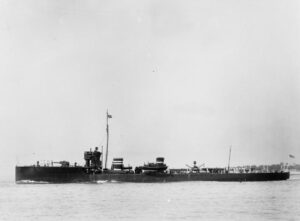 Lawping was built by Cammell Laird as an admiralty design, launched on 29 September 1911 (H56, H48, H09). She was active witrh the 1st Destroyer Flotilla, Grand Fleet in 191 and took part in the Battle of Heligoland Bight led by Fearless. As HMS Laertes was seriously damaged and stopped, she assisted her under heavy fire, trying to tow hher but failing and bot were saved by the intervention of the battlecruiser HMS Lion. On 24 January 1915 she took part in the Battle of Dogger Bank led by Aurora and the Battle of Jutland under Lt.Cdr Alexander Gye. In 1917 she was reassigned with the 3rd Battle Squadron to the Mediterranean and took part in the Battle of Jaffa being part of the Dardanelles allied incursion on on 12 November 1918. Laid up postwar she was sold for BU on 26 October 1921.
Lawping was built by Cammell Laird as an admiralty design, launched on 29 September 1911 (H56, H48, H09). She was active witrh the 1st Destroyer Flotilla, Grand Fleet in 191 and took part in the Battle of Heligoland Bight led by Fearless. As HMS Laertes was seriously damaged and stopped, she assisted her under heavy fire, trying to tow hher but failing and bot were saved by the intervention of the battlecruiser HMS Lion. On 24 January 1915 she took part in the Battle of Dogger Bank led by Aurora and the Battle of Jutland under Lt.Cdr Alexander Gye. In 1917 she was reassigned with the 3rd Battle Squadron to the Mediterranean and took part in the Battle of Jaffa being part of the Dardanelles allied incursion on on 12 November 1918. Laid up postwar she was sold for BU on 26 October 1921.
 HMS Lizard
HMS Lizard
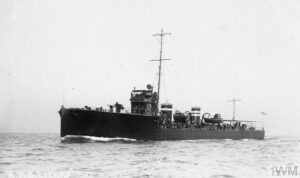 HMS Lizard (H58, H60, H62) was laid down on 1 January 1911 by Cammell Laird, launched on 10 October 1911 and completed in mid-1912. She was part of the 1st Flotilla, was at the Battle of Heligoland Bight and Battle of Jutland and later versed to the 3rd Battle Group and sent to the Mediterranean. She took part in the 20–21 December 1917 Battle of Jaffa, part of the Southern Palestine Offensive. She supported the 52nd Division by naval gunfire with Grafton and Lapwing as well as the monitors M29, M30 and M32.
HMS Lizard (H58, H60, H62) was laid down on 1 January 1911 by Cammell Laird, launched on 10 October 1911 and completed in mid-1912. She was part of the 1st Flotilla, was at the Battle of Heligoland Bight and Battle of Jutland and later versed to the 3rd Battle Group and sent to the Mediterranean. She took part in the 20–21 December 1917 Battle of Jaffa, part of the Southern Palestine Offensive. She supported the 52nd Division by naval gunfire with Grafton and Lapwing as well as the monitors M29, M30 and M32.
Her last action was at the Battle of Imbros in 1918. On 19 January the ex-Breslau and Goeben, now Turkish Midilli and Yavuz passed through the Dardanelles to the Aegean and were shadowed by a RN flotilla stationed to intercept them. Lizard was with the monitor HMS Raglan, M28 and her sister HMS Tigress. M28 and Raglan were outgunned and sunk, but they entered a minefield, Midilli sank and Yavuz was badly damaged but managed to escape. Later she was part of the Otranto Barrage and by April 1918, deployed to the Corfu division. Postwar she was laid up, sold for BU on 4 November 1921.
 HMS Phoenix
HMS Phoenix
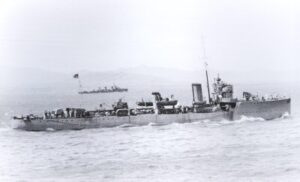 HMS Phoenix (H75; H94) was laid down at Vickers on 4 January 1911, launched on 9 October 1911 and completed in May 1912. She served with the 1rst Destroyer Flotilla, North Sea and Grand Fleet in 1914. She took part first in the action on 16 August 1914, engaging an uninditified enemy cruiser off the mouth of the Elbe later narrated by “Clinker Knocker” in 1938 in what was called the ‘broad fourteens’. It was later though to be an armoured cruiser and Goshawk and Phoenix were disabled. This was either Yorck or Roon. She took part later in the Battle of Heligoland Bight and had a near hit, one man wounded. Later she was present at the Battle of Dogger Bank and the Battle of Jutland on 31 May 1916. On 25 April 1917 while escorting the Australian troopship Ballarat, the latter was torpedoed by a German submarine and later sank the following morning but all 1,752 souls were saved. In September 1917 she was transferred to the 5fth Destroyer Flotilla, Mediterranean and at 9:18 on 14 May 1918 off the Otranto Barrage she was torpedoed amidships by the Austro-Hungarian submarine SM U-27. HMAS Warrego tried to tow her to Valona but she sank. Apart 3 fatalities all the crew was rescued.
HMS Phoenix (H75; H94) was laid down at Vickers on 4 January 1911, launched on 9 October 1911 and completed in May 1912. She served with the 1rst Destroyer Flotilla, North Sea and Grand Fleet in 1914. She took part first in the action on 16 August 1914, engaging an uninditified enemy cruiser off the mouth of the Elbe later narrated by “Clinker Knocker” in 1938 in what was called the ‘broad fourteens’. It was later though to be an armoured cruiser and Goshawk and Phoenix were disabled. This was either Yorck or Roon. She took part later in the Battle of Heligoland Bight and had a near hit, one man wounded. Later she was present at the Battle of Dogger Bank and the Battle of Jutland on 31 May 1916. On 25 April 1917 while escorting the Australian troopship Ballarat, the latter was torpedoed by a German submarine and later sank the following morning but all 1,752 souls were saved. In September 1917 she was transferred to the 5fth Destroyer Flotilla, Mediterranean and at 9:18 on 14 May 1918 off the Otranto Barrage she was torpedoed amidships by the Austro-Hungarian submarine SM U-27. HMAS Warrego tried to tow her to Valona but she sank. Apart 3 fatalities all the crew was rescued.
 HMS Sandfly
HMS Sandfly
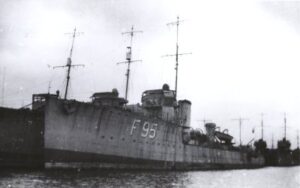 HMS Sandfly was built at Swan Hunter, Wallsend, launched on 9 July 1911. She served with the First Destroyer Flotilla, Grand Fleet in 1914, took part in the Battle of Heligoland Bight, Battle of Dogger Bank with HMS Aurora and was transfer to Third Battle Squadron in November 1916, the converted in 1917 the into a minelaying destroyer to serve with the 20th Flotilla from Immingham. On 31 August 1917 she rescued men from SS Miniota (Canadian Pacific Line) torpedoed by SM U-19, 30 nautical miles (56 km) off Start Point. She tried to tow tow her to Portland Harbour but she sank before. Laid up post World War I, she was sold for BU on 9 May 1921.
HMS Sandfly was built at Swan Hunter, Wallsend, launched on 9 July 1911. She served with the First Destroyer Flotilla, Grand Fleet in 1914, took part in the Battle of Heligoland Bight, Battle of Dogger Bank with HMS Aurora and was transfer to Third Battle Squadron in November 1916, the converted in 1917 the into a minelaying destroyer to serve with the 20th Flotilla from Immingham. On 31 August 1917 she rescued men from SS Miniota (Canadian Pacific Line) torpedoed by SM U-19, 30 nautical miles (56 km) off Start Point. She tried to tow tow her to Portland Harbour but she sank before. Laid up post World War I, she was sold for BU on 9 May 1921.
 HMS Tigress
HMS Tigress
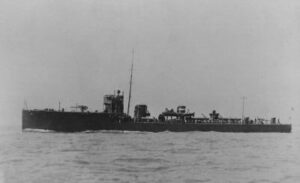 HMS Tigress was the last admirakty design of the Acheron class, built at Hawthorn Leslie, launched on 20 December 1911 (H92, H4A, H61) and by March 1913, she was with the First Destroyer Flotilla, joined the Harwich Force, Grand Fleet, took part in the Battle of Dogger Bank and by late 1917 joined the Fifth Destroyer Flotilla, Mediterranean, taking part in the Battle of Imbros in January 1918. It’s Her and her sister which lanaged to lure the germans out in a minefield, fatal. Captain Lt Cdr J B Newill was awarded the DSO for this action and for rescuing the 162 survivors of the Midilli (former Breslau) in the minefield whilst under fire from shore batteries.
HMS Tigress was the last admirakty design of the Acheron class, built at Hawthorn Leslie, launched on 20 December 1911 (H92, H4A, H61) and by March 1913, she was with the First Destroyer Flotilla, joined the Harwich Force, Grand Fleet, took part in the Battle of Dogger Bank and by late 1917 joined the Fifth Destroyer Flotilla, Mediterranean, taking part in the Battle of Imbros in January 1918. It’s Her and her sister which lanaged to lure the germans out in a minefield, fatal. Captain Lt Cdr J B Newill was awarded the DSO for this action and for rescuing the 162 survivors of the Midilli (former Breslau) in the minefield whilst under fire from shore batteries.
She was present in the Dardanelles and Constantinople on 13 November and postwar, sold on 9 May 1921 for BU.
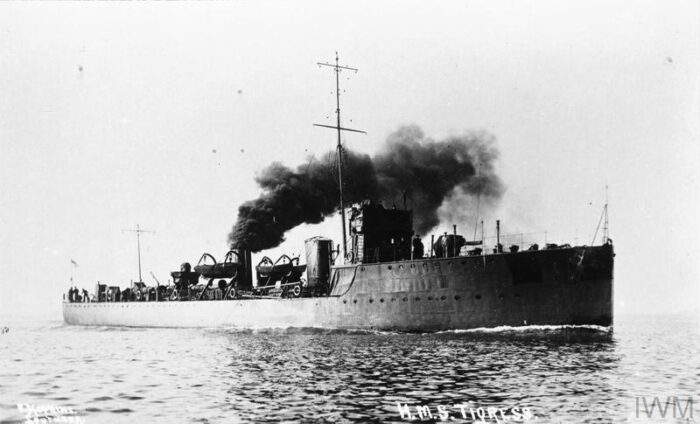
 HMS Firedrake
HMS Firedrake
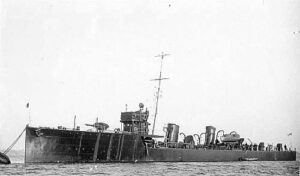 HMS Firedrake was one of the three “Yarrow specials”, probably among the fastest destroyers in the world by 1912. She was Laid down on 1 July 1911, Launched on 9 April 1912 and commissioned on September 1912. She was present in the Curragh Incident in the spring of 1914, despatched to Kingstown (Dún Laoghaire, Ireland) to preserve communications between Lt.General Sir Arthur Paget in Dublin and the British Government during the troubles after leaving on 19 March and setup a record. Fearing Unionist spies, captain Lt.Cdr. B W Barrow report to Paget’s HQ in civilian clothes. She was later withdrawn for Easter leave, and could not prevent further gun-running to the Ulster Volunteers. She was part of the Eighth Submarine Flotilla, Commodore Keyes, of Harwhich, Parkeston Quay. She escorted troopships to France, protecting the BEF and later the Battle of Heligoland Bight, as 26 August 1914 Commodore Keyes made HMS Lurcher his flagship and Firedrake, group leader. Two D-class and six E-class took also positions. In reinfprcement were the destroyers of Commodore Reginald Tyrwhitt. On 28th August at Daylight on the 28th August, HMS Lurcher and Firedrake proceeded towards Heligoland behind E6, E7 and E8 forging ahead, and misty condition create the danger of fratricidal attacks as at 8:15 am, Firedrake and Lurcher mistook the cruisers Lowestoft and Nottingham for Germans, but recoignised them later.
HMS Firedrake was one of the three “Yarrow specials”, probably among the fastest destroyers in the world by 1912. She was Laid down on 1 July 1911, Launched on 9 April 1912 and commissioned on September 1912. She was present in the Curragh Incident in the spring of 1914, despatched to Kingstown (Dún Laoghaire, Ireland) to preserve communications between Lt.General Sir Arthur Paget in Dublin and the British Government during the troubles after leaving on 19 March and setup a record. Fearing Unionist spies, captain Lt.Cdr. B W Barrow report to Paget’s HQ in civilian clothes. She was later withdrawn for Easter leave, and could not prevent further gun-running to the Ulster Volunteers. She was part of the Eighth Submarine Flotilla, Commodore Keyes, of Harwhich, Parkeston Quay. She escorted troopships to France, protecting the BEF and later the Battle of Heligoland Bight, as 26 August 1914 Commodore Keyes made HMS Lurcher his flagship and Firedrake, group leader. Two D-class and six E-class took also positions. In reinfprcement were the destroyers of Commodore Reginald Tyrwhitt. On 28th August at Daylight on the 28th August, HMS Lurcher and Firedrake proceeded towards Heligoland behind E6, E7 and E8 forging ahead, and misty condition create the danger of fratricidal attacks as at 8:15 am, Firedrake and Lurcher mistook the cruisers Lowestoft and Nottingham for Germans, but recoignised them later.
She later took part in the rescue of the cruiser Mainz’s crew with Liverpool and Lurcher. On 22 September 1914 again with Lurcher she towed the submarines E1 and E5 towards the Skagerrak for an attempt to breakout in the Baltic.
She also also was assigned a position during the German raid on British shores, the Raid on Scarborough, Hartlepool and Whitby. She moved to the to Heligoland Bight to intercept returning German ships but failed, with SMS Posen missed by HMS E11. On 7 January 1915 Firedrake and Lurcher looked for the missing C31 off the Belgian coast.
On 27 April 1916 she managed to capture intact the German submarine UC-5 (Oberleutnant zur See Ulrich Mohrbutter) after she ran aground on Shipwash Shoal. UC-5 was towed to Harwich, drydocked and repaired for exhibition in Central Park and captain, Aubrey Thomas Tillard was mentioned in despatches. Postwar she wa sold for BU on 10 October 1921.
 HMS Lucher
HMS Lucher
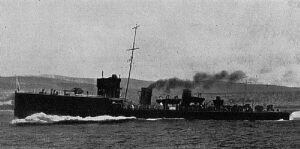 HMS Lurcher was a Yarrow “special” Launched on 1 June 1912. With Firedrake she was assigned to the 8th Submarine Flotilla (Commodore Roger Keyes) at Parkeston Quay, Harwich. They both escorted and trained with submarines for combined operations. She took part in the Battle of Heligoland Bight with her sister, all the above. On 22 September 1914 she towed the submarines E1 towards the Skagerrak. In the Raid on Scarborough, Hartlepool and Whitby she took stations off the island of Terschelling but failed to intercept the returning battlecruisers or catch Rear Admiral Franz Hipper on 17 December. Later she took part in the Search for HM Submarine C31 (mined off the Belgian coast on 4 January 1915). She left Harwich on 30 May with HM E31, E53 and D6 to patrol between Southwold and the Dutch coast and missed the Battle of Jutland later.
HMS Lurcher was a Yarrow “special” Launched on 1 June 1912. With Firedrake she was assigned to the 8th Submarine Flotilla (Commodore Roger Keyes) at Parkeston Quay, Harwich. They both escorted and trained with submarines for combined operations. She took part in the Battle of Heligoland Bight with her sister, all the above. On 22 September 1914 she towed the submarines E1 towards the Skagerrak. In the Raid on Scarborough, Hartlepool and Whitby she took stations off the island of Terschelling but failed to intercept the returning battlecruisers or catch Rear Admiral Franz Hipper on 17 December. Later she took part in the Search for HM Submarine C31 (mined off the Belgian coast on 4 January 1915). She left Harwich on 30 May with HM E31, E53 and D6 to patrol between Southwold and the Dutch coast and missed the Battle of Jutland later.
In May 1917 she collided with and sank C17, but se was raised, later repaired and returned to service. The action took place after noon on 6 July 1918 when two British subs were attacked by a squadron of five German seaplanes returning from Lowestoft, strafing their CT with a machine-gun killing C31’s captain and staff, mortally wounding the coxswain. She also lost her steering gear, compasses and radio. E51 tried to tow her but the seaplanes came back for another raid, until te arrival of HMS Lurcher.
She survived the war and was sold on 9 June 1921.
 HMS Oak
HMS Oak
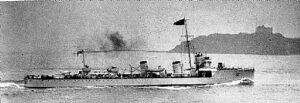 Third and last “special” from Yarrow, she was launched on 5 September 1912. During her carrer she had the pennants H12, H38, H92, H56. HMS Oak was a tender to the flagship of the Grand Fleet and took part in the Battle of Jutland under Lieutenant Commander Douglas Faviell. Her hull was painted white to make a difference. She often carried the most important visitors and notably King George V himelf when he travelled to Scapa Flow in 1915 for a two-day review but also Lord Kitchener to Scapa Flow on 5 June 1916. This was fateful as she transferred him to the cruiser Hampshire, hit a mine and sank the same day in the evening, with only 12 survivors.
Third and last “special” from Yarrow, she was launched on 5 September 1912. During her carrer she had the pennants H12, H38, H92, H56. HMS Oak was a tender to the flagship of the Grand Fleet and took part in the Battle of Jutland under Lieutenant Commander Douglas Faviell. Her hull was painted white to make a difference. She often carried the most important visitors and notably King George V himelf when he travelled to Scapa Flow in 1915 for a two-day review but also Lord Kitchener to Scapa Flow on 5 June 1916. This was fateful as she transferred him to the cruiser Hampshire, hit a mine and sank the same day in the evening, with only 12 survivors.
Lastely she carried German Rear-Admiral Hugo Meurer from the cruiser Königsberg for the formal Fleet surrender on 15 November 1918 to Admiral Sir David Beatty which was on board flagship HMS Queen Elizabeth in the Firth of Forth. Next she was part of Operation ZZ, with 60 Allied battleships escorting the Hochseeflotte and its 11 battleships, 5 battlecruisers, 8 cruisers and 48 destroyers. On 20 November 1918 King George V, Queen Mary and the Prince of Wales embarked in Oak (a contraction fomr some of “Royal Oak” second ship under this short name). She was preceded by the destroyer Verdun and steamed through the fleet flying the Royal Standard at her mainmast, cheered by the while escort. She was sold in May 1921.
Read More/Src
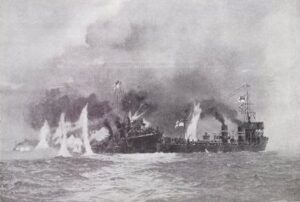 HMS Lawping trying to protect and take in tow the crippled HMS Laertes during the Battle of Heligoland bay in August 1914. Her captain Lieutenant-Commander Alexander Gye was mentioned in the dispatched by Beatty, which saved both aboard his flagship HMS Lion. She also took part in the Dogger Bank and Jutland, battle of Jaffa in the Mediterranean. Her career in WWI ended under the Minarets of Constantinople. She coukd have been saved from the scrapyard in 1921 but that was not usual at the time, especially under the economical duress UK endured by that time.
HMS Lawping trying to protect and take in tow the crippled HMS Laertes during the Battle of Heligoland bay in August 1914. Her captain Lieutenant-Commander Alexander Gye was mentioned in the dispatched by Beatty, which saved both aboard his flagship HMS Lion. She also took part in the Dogger Bank and Jutland, battle of Jaffa in the Mediterranean. Her career in WWI ended under the Minarets of Constantinople. She coukd have been saved from the scrapyard in 1921 but that was not usual at the time, especially under the economical duress UK endured by that time.
Books
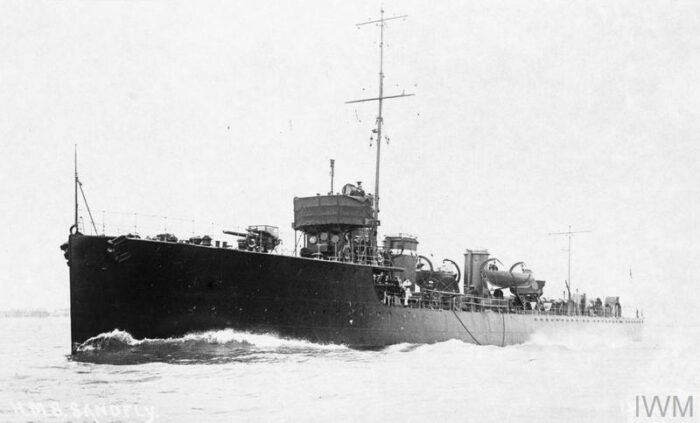
Brown, David K. (2010). The Grand Fleet: Warship Design and Development 1906–1922. Barnsley, UK: Seaforth Publishing.
Cocker, Maurice (1983). Destroyers of the Royal Navy, 1893-1981. Ian Allan.
Dittmar, F.J.; Colledge, J.J. (1972). British Warships 1914–1919. Shepperton, UK: Ian Allan.
Friedman, Norman (2009). British Destroyers: From Earliest Days to the Second World War. Barnsley, UK
Gardiner, Robert; Gray, Randal, eds. (1985). Conway’s All The World’s Fighting Ships 1906–1921. Conway MP.
Manning, T.D. (1961). The British Destroyer. London: Putnam.
Smith, Peter C. (2005). Into the Minefields: British Destroyer Minelaying 1916–1960. Barnsley, UK: Pen & Sword Maritime.
Moore, John (1990). Jane’s Fighting Ships of World War I. London: Studio.
Links
On dreadnoughtproject.org
on battleships-cruisers.co.uk/
on www.gwpda.org/
on worldwar1.co.uk heligoland-oob.html
uboat.net UC19
on worldwar1.co.uk/
naval-history.net 1918-08Aug.htm
web.archive.org/ bobhenneman.info/
books.google.fr/
en.wikipedia.org: Acheron-class_destroyer
navypedia.org/
commons.wikimedia.org Category:Acheron_class
navweaps.com/
web.archive.org/ navy.gov.au/ Units_entitlement_list.pdf
web.archive.org/ navy.gov.au/ Navy_Marks 109th Birthday…

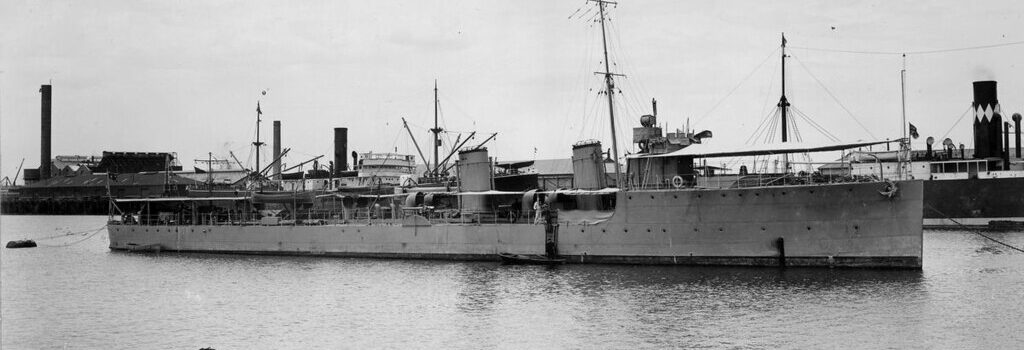
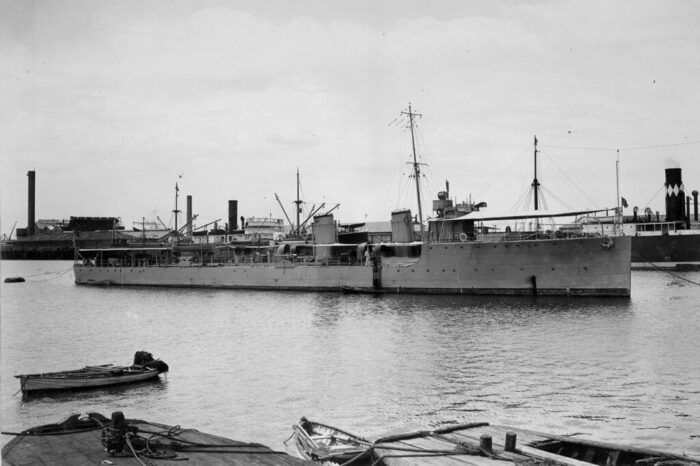
 Latest Facebook Entry -
Latest Facebook Entry -  X(Tweeter) Naval Encyclopedia's deck archive
X(Tweeter) Naval Encyclopedia's deck archive Instagram (@navalencyc)
Instagram (@navalencyc)





 French Navy
French Navy Royal Navy
Royal Navy Russian Navy
Russian Navy Armada Espanola
Armada Espanola Austrian Navy
Austrian Navy K.u.K. Kriegsmarine
K.u.K. Kriegsmarine Dansk Marine
Dansk Marine Nautiko Hellenon
Nautiko Hellenon Koninklije Marine 1870
Koninklije Marine 1870 Marinha do Brasil
Marinha do Brasil Osmanlı Donanması
Osmanlı Donanması Marina Do Peru
Marina Do Peru Marinha do Portugal
Marinha do Portugal Regia Marina 1870
Regia Marina 1870 Nihhon Kaigun 1870
Nihhon Kaigun 1870 Preußische Marine 1870
Preußische Marine 1870 Russkiy Flot 1870
Russkiy Flot 1870 Svenska marinen
Svenska marinen Søværnet
Søværnet Union Navy
Union Navy Confederate Navy
Confederate Navy Armada de Argentina
Armada de Argentina Imperial Chinese Navy
Imperial Chinese Navy Marinha do Portugal
Marinha do Portugal Mexico
Mexico Kaiserliche Marine
Kaiserliche Marine 1898 US Navy
1898 US Navy Sovietskiy Flot
Sovietskiy Flot Royal Canadian Navy
Royal Canadian Navy Royal Australian Navy
Royal Australian Navy RNZN Fleet
RNZN Fleet Chinese Navy 1937
Chinese Navy 1937 Kriegsmarine
Kriegsmarine Chilean Navy
Chilean Navy Danish Navy
Danish Navy Finnish Navy
Finnish Navy Hellenic Navy
Hellenic Navy Polish Navy
Polish Navy Romanian Navy
Romanian Navy Turkish Navy
Turkish Navy Royal Yugoslav Navy
Royal Yugoslav Navy Royal Thai Navy
Royal Thai Navy Minor Navies
Minor Navies Albania
Albania Austria
Austria Belgium
Belgium Columbia
Columbia Costa Rica
Costa Rica Cuba
Cuba Czechoslovakia
Czechoslovakia Dominican Republic
Dominican Republic Haiti
Haiti Hungary
Hungary Honduras
Honduras Estonia
Estonia Iceland
Iceland Eire
Eire Equador
Equador Iran
Iran Iraq
Iraq Latvia
Latvia Liberia
Liberia Lithuania
Lithuania Mandchukuo
Mandchukuo Morocco
Morocco Nicaragua
Nicaragua Persia
Persia San Salvador
San Salvador Sarawak
Sarawak Uruguay
Uruguay Venezuela
Venezuela Zanzibar
Zanzibar Warsaw Pact Navies
Warsaw Pact Navies Bulgaria
Bulgaria Hungary
Hungary

 Bundesmarine
Bundesmarine Dutch Navy
Dutch Navy Hellenic Navy
Hellenic Navy Marina Militare
Marina Militare Yugoslav Navy
Yugoslav Navy Chinese Navy
Chinese Navy Indian Navy
Indian Navy Indonesian Navy
Indonesian Navy JMSDF
JMSDF North Korean Navy
North Korean Navy Pakistani Navy
Pakistani Navy Philippines Navy
Philippines Navy ROKN
ROKN Rep. of Singapore Navy
Rep. of Singapore Navy Taiwanese Navy
Taiwanese Navy IDF Navy
IDF Navy Saudi Navy
Saudi Navy Royal New Zealand Navy
Royal New Zealand Navy Egyptian Navy
Egyptian Navy South African Navy
South African Navy






























 Ukrainian Navy
Ukrainian Navy dbodesign
dbodesign
in the Warrego part of this article you make the following statement;
“was ordered on 6 February 1909, the first ship to be ordered for the Commonwealth Naval Forces. She was also the first warship assembled in Austria.”
I am sure you mean sge was the “furst warship assembled in Australia” and NOT “the first warship assembled in Austria” as you have written
Well spotted, fixed, thanks !